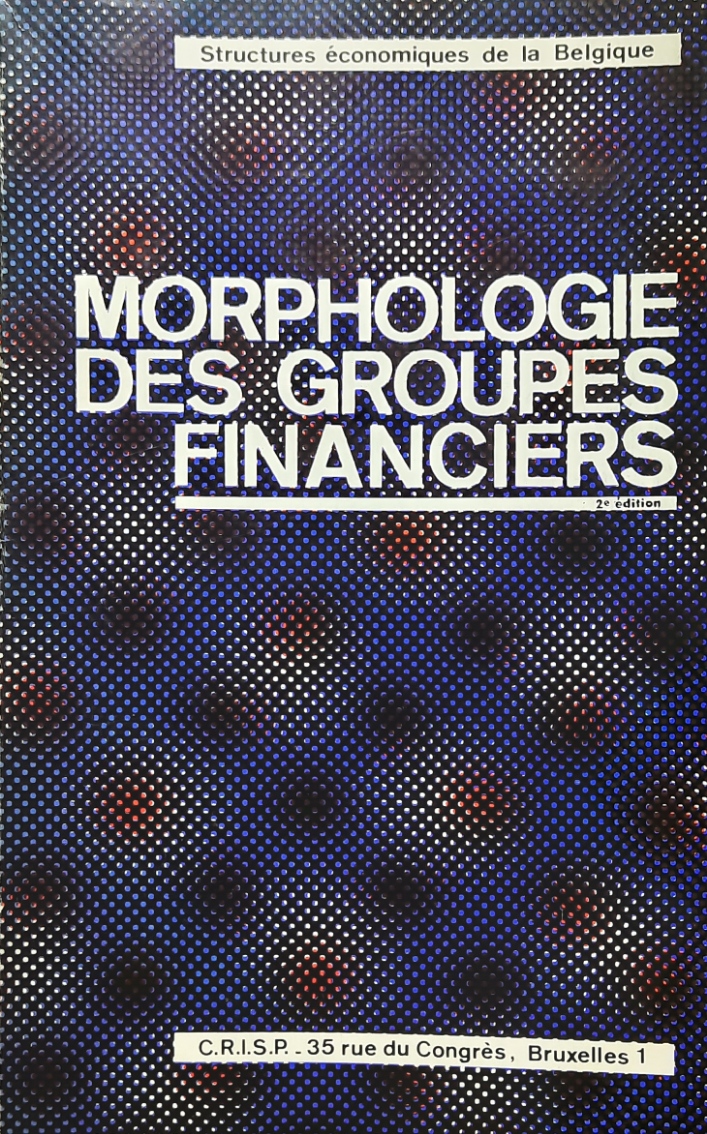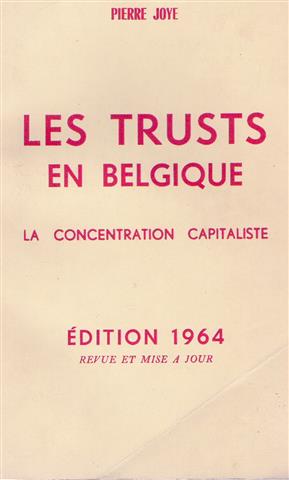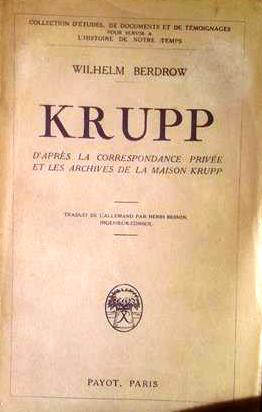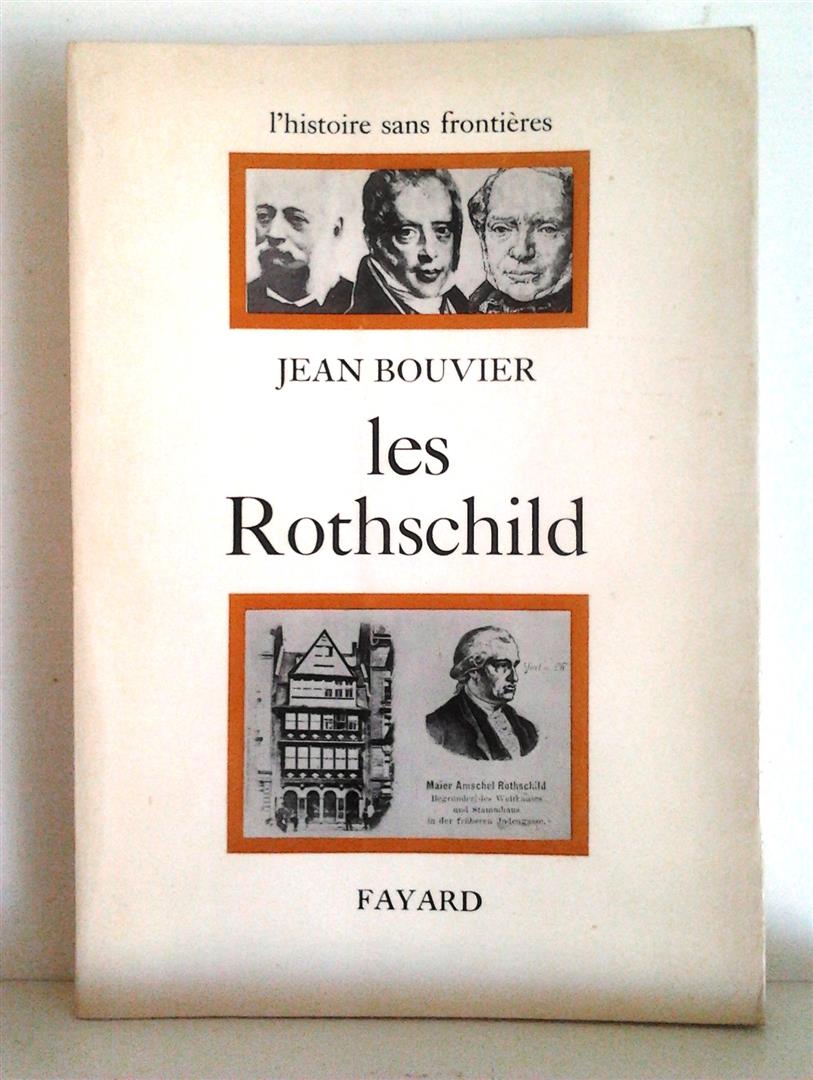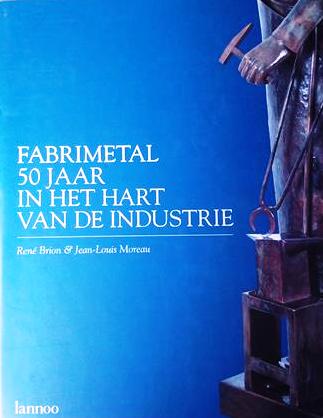



Search
Search our 7.940 News Items
CATEGORIES
We found 134 books in our category 'INDUSTRY'
We found 19 news items
We found 134 books

Madrid
Loewe.
1996
ESP
condition: Small discolorated spot on cover (left), otherwise very fine.
book number: 19960024
Loewe 1846-1996
1st Quarto, orange cloth with leather label. Lavish monograph on Spanish leatherworking firm.
ARGULLOL Rafael e.a.@ wikipedia
€ 10.0
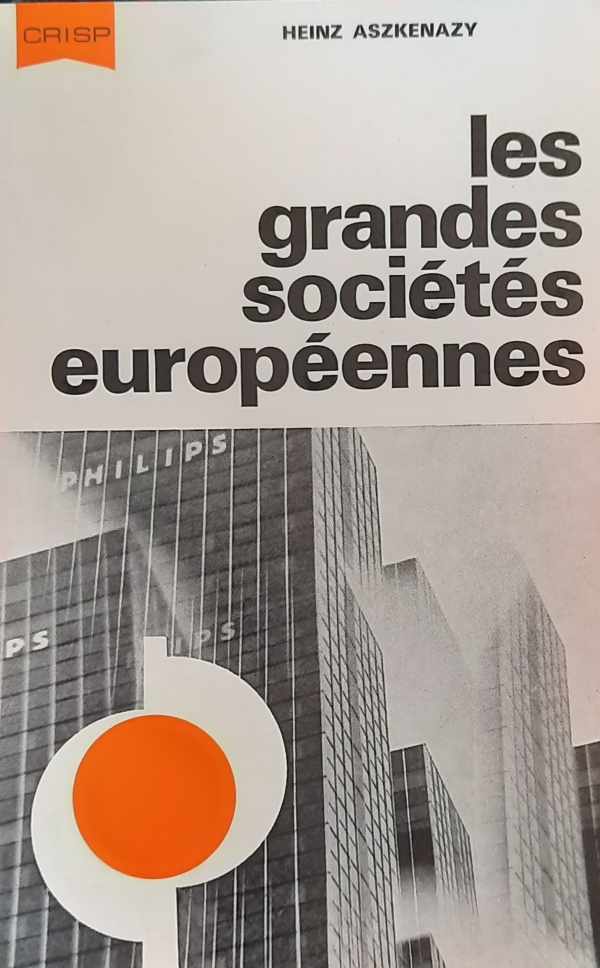
Bruxelles
CRISP
1971
INT 
condition: Very good/Très bel état/Sehr gut/Zeer goed
book number: 202305050027
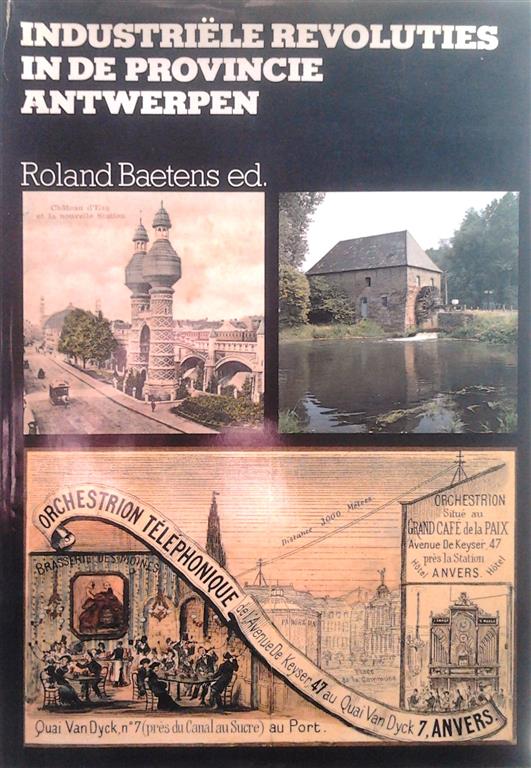
Antwerpen
Standaard Boekhandel
1984
BEL 
condition: Very good/Très bel état/Sehr gut/Zeer goed
book number: 202208020117
Industriële revoluties in de provincie Antwerpen
Hardcover, groen linnen met goudopdruk, geïllustreerde stofwikkel, 467 pp. Illustraties en foto's in ZW en kleur. Tabellen (vaak lange reeksen) en grafieken. Bibliografische noten. Index op persoonsnamen en zaakregister. Referentiewerk.
BAETENS Roland (editor)@ wikipedia
€ 30.0

Paris
Presses Universitaire de France
1979
INT 
condition: Good
book number: 19723
La Pétrochimie dans le monde
Pb, 126 pp. Bibliography.
BAKIS Henry & GUGLIELMO Raymond@ wikipedia
€ 10.0

HISTOIRE DU COMMERCE ET DE L' INDUSTRIE DE LA BELGIQUE DEPUIS LES TEMPS PLUS RECULES JUSQU'EN 1880
3ième édition revue et modifiée. Hardcover, in-8, 334 pp.
BARLET Edouard@ wikipedia
€ 25.0

Berlin
Ludwigshafen am Rhein
1965
condition: Good
book number: 202302011617
100 Jahre BASF. Aus der Forshung
Hardcover, in-8, 850 pp.
BASF@ wikipedia
€ 10.0
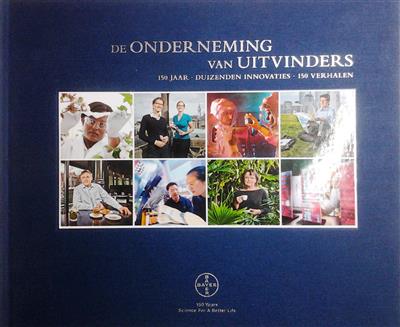
Leverkusen
Bayer AG Konzernkommunikation
2013
DEU 
condition: as new
book number: 201411151740
BAYER: de onderneming van uitvinders. 150 jaar - duizenden innovaties - 150 verhalen
Hardcover, linnen, 4to, oblong, 382 pp., illustraties. Bayer draait geconsolideerd een omzet van 40 miljard EUR.
BAYER, SCHNEIDER Katrin Dr, SCHADE Michael@ wikipedia
€ 25.0
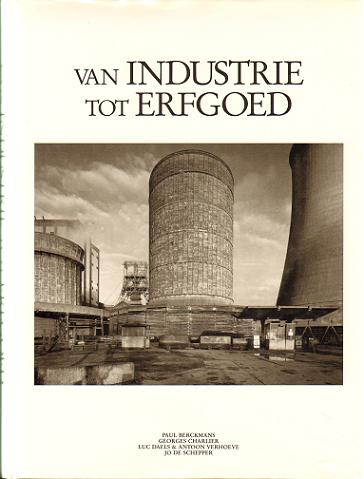
Brussel
Stichting Monumenten- en Landschapszorg.
1989
BEL 
condition: As new/comme neuf/wie neu/als nieuw
book number: 19890200
Van Industrie tot Erfgoed
Hardcover, linnen, stofwikkel, gebonden, 168 pp., 25,5x33,5cm. Illustraties in ZW en kleur. Bibliografie. Industriële archeologie in het landschap. De ontwikkeling van de fabriek en van fabrieksarbeid in Vlaanderen. Fotografische opnames (alle van een opname-datum voorzien). Summary in English. Résumé en français. Noot LT: Bijzonder interessant is het hoofdstuk over de veenexploitatie tussen Kalmthout en Essen en de afvoer van turf via vaarten (aangelegd tussen 1450 en 1715). Eveneens droogmalen van De Moeren nabij Veurne (vanaf 1619).
BERCKMANS Paul, CHARLIER Georges, DAELS Luc, VERHOEVE Antoon, DE SCHEPPER Jo@ wikipedia
€ 20.0
Krupp. D'après la correspondance intime et les archives de la Maison Krupp.
Collection d'études, de documents et de témoignages pour servir à l'histoire de notre temps. Broché, in-8, 534 pp.
BERDROW Wilhelm@ wikipedia
€ 10.0
![Book cover 19990083: BIASI Pierre-Marc et DOUPLITZKY Karine | La saga du papier [histoire du papier]](https://www.mers.be/COVERS_MERS/19990083.jpg)
Paris
Luc Pire
1999
INT 
condition: As new/comme neuf/wie neu/als nieuw
book number: 19990083
La saga du papier [histoire du papier]
Broché, In-4, jaquette à rabats, emboitage illustré/illustrated slipcase, 255 pp. Illustrations en NB et couleurs. Bibliographie, index. Ouvrage important sur l'histoire du papier.
BIASI Pierre-Marc et DOUPLITZKY Karine @ wikipedia
€ 75.0
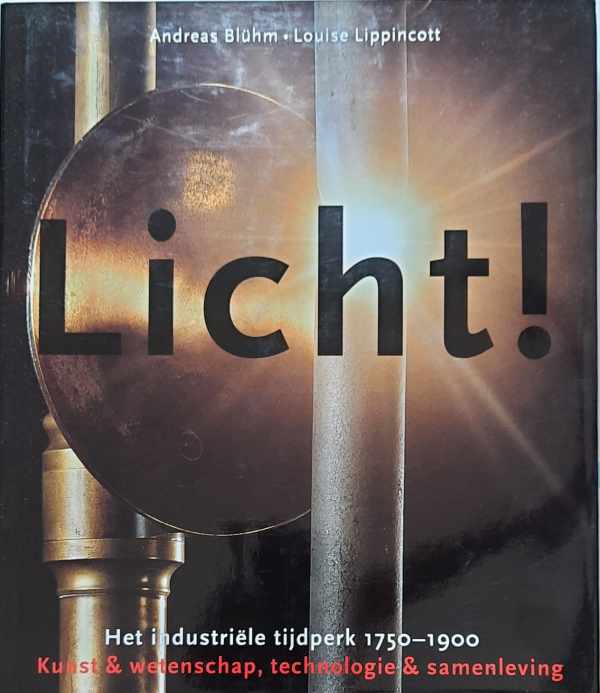
Amsterdam / Pittsburgh / Zwolle
Van Gogh Museum / Carnegie Museum of Art / Waanders
2000
INT 
condition: As new/comme neuf/wie neu/als nieuw
book number: 20000094
Licht! Het industriële tijdperk 1750-1900. Kunst & wetenschap, technologie & samenleving.
Hardcover, linnen met goudopdruk, met geïll. stofwikkel, gebonden, large 4to, 272 pp., illustraties in kleur en ZW. Bij de gelijknamige tentoonstelling, Van Gogh Museum 20/10/2000 tot 11/2/2001. Bibliografie, index. Soms verrassende invalshoeken op de lichtbron. Opvallend hoe ook licht via de elektriciteit een grootindustrie werd.
BLÜHM Andreas & LIPPINCOTT Louise@ wikipedia
€ 10.0
![Book cover 19720098: BOLLE Jacques (redactie), NOKIN Max (inleiding) | Société Générale de Belgique 1822-1972 [Nederlandstalige uitgave]](https://www.mers.be/COVERS_MERS/19720098.jpg)
Brussel
Société Générale
1972
BEL 
condition: Zonder stofwikkel. Very good.
book number: 19720098
Société Générale de Belgique 1822-1972 [Nederlandstalige uitgave]
Hardcover, linnen, goudopdruk, small 4to, 264 pp. Illustraties en foto's in kleur en ZW. Jubileumboek belicht de dominante rol van de Société Générale in het Belgische en het Congolese bedrijfsleven. Opvallend is toch wel het niet vertalen van de benaming van de holding, wat meteen de franstalige stempel aanduidt. De geïllustreerde schutbladen - het Zoniënwoud rond Brussel - zijn een indirecte verwijzing naar de origine van de groep: onroerend goed in handen van Willem I.
BOLLE Jacques (redactie), NOKIN Max (inleiding)@ wikipedia
€ 25.0
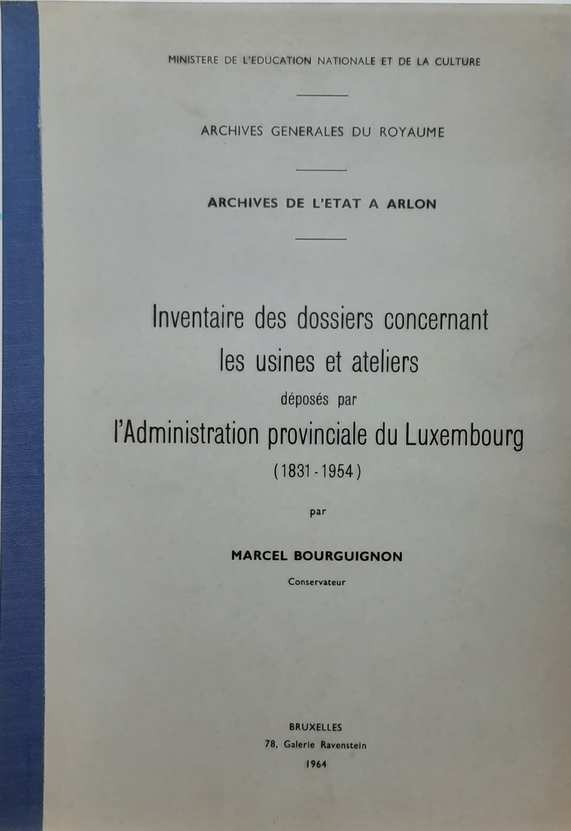
Bruxelles
AGR, Archives de l'Etat à Arlon
1964
BEL 
condition: dos coupé, feuilles volantes, très bon état
book number: 202104280140
Inventaire des dossiers concernant les usines et ateliers déposés par l'Administration provinciale du Luxembourg (1831-1954)
Broché, A4, offset, ix + 147 pp., index.
Avec une introduction sur la portée des dossiers mentionnés.
'Parmi les dossiers déposés aux Archives de l'Etat par 1'Administration provinciale, principalement de 1932 a 1946, figurent ceux qui etaient conservés sous la rubrique Usines sur les cours d'eau. Ils étaient
groupés en une ample série de fardes dont certaines étaient classées par dates, d'autres par communes, d'autres encore par objets. L'ensemble occupait un rayonnage d'une vingtaine de mètres qui s'est, depuis, notablement accru.'
Avec une introduction sur la portée des dossiers mentionnés.
'Parmi les dossiers déposés aux Archives de l'Etat par 1'Administration provinciale, principalement de 1932 a 1946, figurent ceux qui etaient conservés sous la rubrique Usines sur les cours d'eau. Ils étaient
groupés en une ample série de fardes dont certaines étaient classées par dates, d'autres par communes, d'autres encore par objets. L'ensemble occupait un rayonnage d'une vingtaine de mètres qui s'est, depuis, notablement accru.'
BOURGUIGNON Marcel, Conservateur@ wikipedia
€ 30.0
Les Rothschild (nouvelle édition augmentée)
Broché, in-8, 352 pp. Bibliographie. Réédition améliorée et augmentée de deux chapitres nouveaux, un sur la branche anglaise des Rothschild dans la seconde moitié du XIXe siècle, l'autre sur les Rothschild de Paris au XXe siècle, avec une mise au point sur leur situation actuelle. Jean Bouvier (1920-1987) est un historien français. Il a été professeur à l'École des hautes études de Vincennes et à la Sorbonne. D'inspiration marxiste mais sans aucun sectarisme, il a été l'un des pionniers de l'histoire du temps présent. Ses recherches, attentives aux transformations de la société, ont porté principalement sur l'économie et particulièrement sur la banque. Il s'est toujours efforcé de fonder ses travaux sur une analyse critique des observations statistiques.


BOUVIER Jean@ wikipedia
€ 20.0

London
Octopus Books
1984
GBR 
condition: Very good/Très bel état/Sehr gut/Zeer goed
book number: 202207111715
Marks & Spencer 1884-1984. A centenary history.
Hardcover, dj, 4to, 128 pp., illustrations, index.
Based on the archives of M&S.
Based on the archives of M&S.
BRIGGS Asa@ wikipedia
€ 20.0
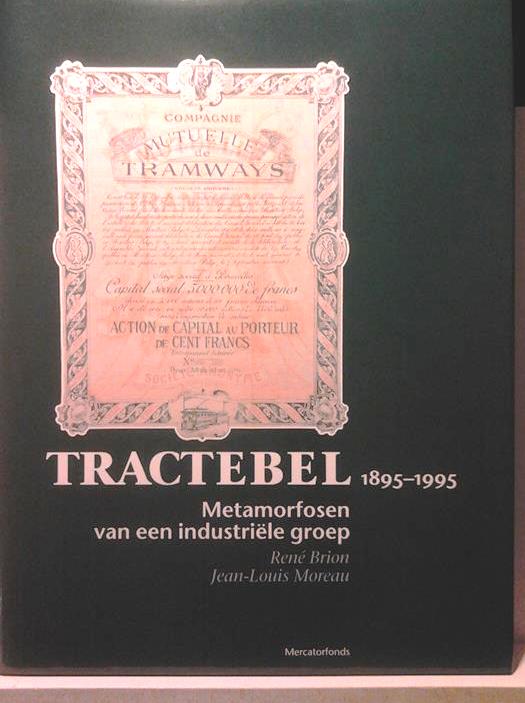
Antwerpen
Mercatorfonds
1995
BEL 
condition: As new/comme neuf/wie neu/als nieuw
book number: 201603051849
Tractebel 1895-1995. Metamorfosen van een industriële groep
Hardcover, linnen band, stofwikkel, in origineel foedraal, 4to, 344 pp., rijkelijk geïllustreerd in kleur en ZW, foto's. Toegevoegd: kleine brochure ter aankondiging van het boek + brief van Philippe Bodson, Voorzitter van de Algemene Directie + schema met de genealogie van Tractebel. Opgelet: zwaargewicht.
Noot LT: Doorheen heel de geschiedenis is er de strijd geweest voor de macht over de energiesector. Moest die bij de staat of bij privé-eigenaars liggen? En rekende men niet vaak te hoge tarieven aan aan de particulieren om de tarieven aan de industrie (waarin men belangen had) laag te kunnen houden? Het zijn discussies die in de jaren 30 hevig gevoerd werden (bvb. Plan De Man) en die de socialisten gaandeweg hebben losgelaten naargelang zij zitjes kregen in de betrokken ondernemingen en de gemengde intercommunales.
Dit werk werpt ook een beperkt licht op de sector van de radiodistributie en de teledistributie (°19601110, Coditel/°1970, Coditel Vlaanderen)(pp. 257 e.v.) Opmerkelijk is dat in 1964 de NIM (°1960) een participatie van 32% in Coditel nam. In 1994 kwam de NIM in handen van de Antwerpse holding Ackermans & van Haaren (A&vH).
Tractebel was ook actief in Belgisch Congo (p. 273 e.v.). Dat gebeurde via Traction, Electrobel, Sofina en Electrorail die studies ondernamen van centrales en lijnen. Er wordt verwezen naar de hydrocentrales van Bia, Le Marinel, Delcommune. De collusie van staats- en privé-kapitaal greep daar wel plaats, iets wat de groepen in België niet wensten. De electrificatie van de spoorweg in Congo was uitsluitend op Katanga gericht. Speciale aandacht ook voor het Inga-project. (p. 276 e.v.)
Tenslotte kan men ook de evolutie van de kernenergie lezen in deze puike bedrijfsmonografie (groepsmonografie).
Hieronder de structuur eind jaren 90:
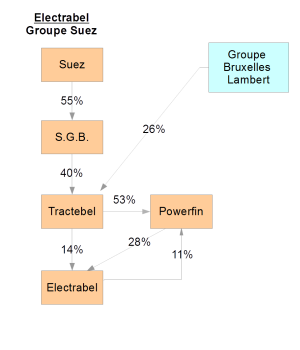
Noot LT: Doorheen heel de geschiedenis is er de strijd geweest voor de macht over de energiesector. Moest die bij de staat of bij privé-eigenaars liggen? En rekende men niet vaak te hoge tarieven aan aan de particulieren om de tarieven aan de industrie (waarin men belangen had) laag te kunnen houden? Het zijn discussies die in de jaren 30 hevig gevoerd werden (bvb. Plan De Man) en die de socialisten gaandeweg hebben losgelaten naargelang zij zitjes kregen in de betrokken ondernemingen en de gemengde intercommunales.
Dit werk werpt ook een beperkt licht op de sector van de radiodistributie en de teledistributie (°19601110, Coditel/°1970, Coditel Vlaanderen)(pp. 257 e.v.) Opmerkelijk is dat in 1964 de NIM (°1960) een participatie van 32% in Coditel nam. In 1994 kwam de NIM in handen van de Antwerpse holding Ackermans & van Haaren (A&vH).
Tractebel was ook actief in Belgisch Congo (p. 273 e.v.). Dat gebeurde via Traction, Electrobel, Sofina en Electrorail die studies ondernamen van centrales en lijnen. Er wordt verwezen naar de hydrocentrales van Bia, Le Marinel, Delcommune. De collusie van staats- en privé-kapitaal greep daar wel plaats, iets wat de groepen in België niet wensten. De electrificatie van de spoorweg in Congo was uitsluitend op Katanga gericht. Speciale aandacht ook voor het Inga-project. (p. 276 e.v.)
Tenslotte kan men ook de evolutie van de kernenergie lezen in deze puike bedrijfsmonografie (groepsmonografie).
Hieronder de structuur eind jaren 90:

BRION RENE & MOREAU JEAN-LOUIS@ wikipedia
€ 30.0
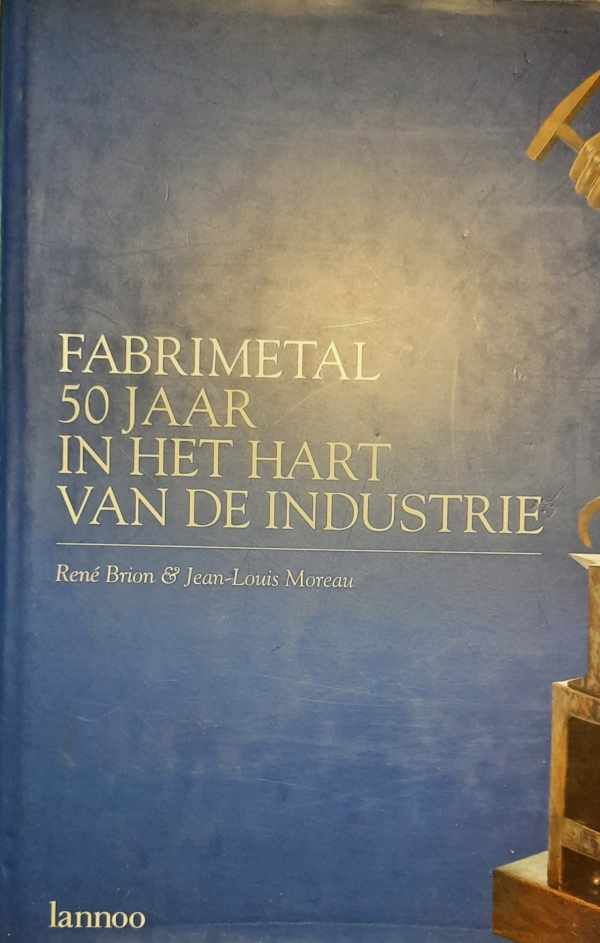
Tielt
Lannoo
1996
BEL 
condition: Goede staat
book number: 202207052350
Fabrimetal, 50 jaar in het hart van de industrie: Kroniek van een federatie
Hardcover, gebonden in blauw linnen met zilveropdruk, stofwikkel, 4to, 223 pp., illustraties en foto's in kleur en ZW. Met bibliografische noten en bibliografie.
BRION René, MOREAU Jean-Louis @ wikipedia
€ 20.0

Antwerp
Fonds Mercator
1995
BEL 
condition: As new/comme neuf/wie neu/als nieuw
book number: 19950033
Tractebel 1895-1995: Metamorphoses of an Industrial Group
Hardcover 25 x 33 cm, 344 pp. dust jacket very fine/VF. Illustrations, photos, maps, index, bibliography. In VG illustrated slipcase. Text in English. Superb! Weight: 2.950 gram
BRION René, MOREAU Jean-Louis @ wikipedia
€ 50.0
Fabrimetal, 50 jaar in het hart van de industrie: Kroniek van een federatie
Hardcover, gebonden in blauw linnen met zilveropdruk, stofwikkel, 4to, 223 pp., illustraties en foto's in kleur en ZW. Met bibliografische noten en bibliografie.
BRION René, MOREAU Jean-Louis @ wikipedia
€ 20.0
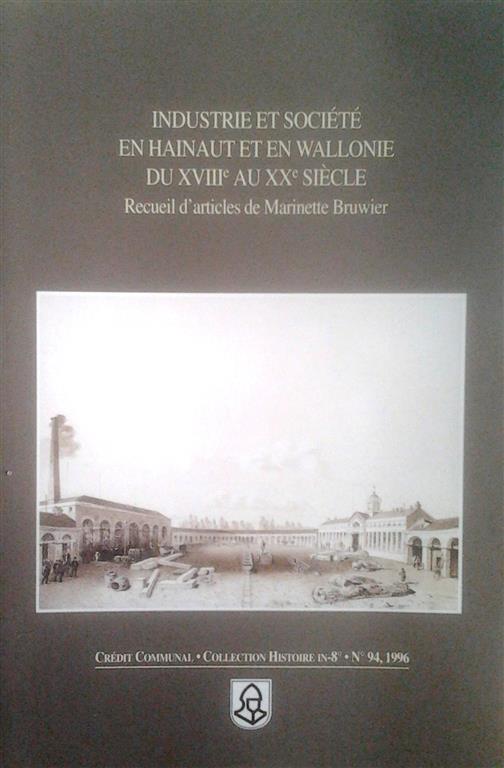
Bruxelles
CCB
1996
BEL 
condition: As new/comme neuf/wie neu/als nieuw
book number: 201610051047
Industrie et société en Hainaut et en Wallonie du XVIIIe au Xxe siècle. Receuil d'articles de Marinette Bruwier.
Collection Histoire in-8, n° 94. Pb 414 pp. + la liste des publications du Crédit Communal: I. Collection histoire série in-8: nos 1-93 (1966-1994); II. Coll. hist. série in-4to (1965-1996), III. Coll. Atlas historique des villes de Belgique (in 4to). Bibliographie. Note LT: Marinette Bruwier (°Mons, 7/2/1922) fut archiviste du CCB de 1958 à 1963, et Présidente du Comité d'Histoire du CCB. Fort intéressante est sa contribution de 1983 "Le rôle économique du canal Charleroi-Bruxelles" (pp. 287-295)
BRUWIER Marinette@ wikipedia
€ 25.0
We found 19 news items
PwC in trouble over tax consulting
ID: 202305242332
It’s no secret the Australian government relies on consulting firms to complete necessary work. But a growing tax leak scandal at PwC Australia has led to a reckoning for the lucrative consulting industry over the role it plays in the murky world of tax minimization.
At the center of the scandal is Peter Collins, a senior PwC tax expert, who was outed by ICIJ partner the Australian Financial Review for using secret government information to advise clients — Google, Apple and Microsoft likely among them — on how to sidestep new tax laws. Internal emails confirmed Collins shared the intel with dozens of his colleagues and PwC used it to book millions in fees within hours of laws, meant to curb tax avoidance, being announced in 2015.
Collins was banned from acting as a tax practitioner, while his boss, Tom Seymour, stepped down from his role as CEO of the Australian arm of the accounting giant once known as PricewaterhouseCoopers. But the consequences have spread further, well beyond an amusing skewering by the Australian public broadcaster. So, what next?
The matter has already engulfed parts of PwC’s global operation and was this week referred to the Australian Federal Police by the Treasury. Meanwhile, the Australian treasurer has promised to “crack down” on consultants that abuse their access to confidential government information, though he has yet to reveal what exactly the “further steps” he intends to take might entail.
Some lawmakers have called for the PwC team members involved, and the companies they advised, to be named and shamed. Others want the firm banned from government contracts. But, with the government forking out at least a billion dollars a year to consultants, as one senator put it: “The bigger question remains, are we looking at just the tip of the iceberg; what is going on in the larger industry of big consulting?”
At the center of the scandal is Peter Collins, a senior PwC tax expert, who was outed by ICIJ partner the Australian Financial Review for using secret government information to advise clients — Google, Apple and Microsoft likely among them — on how to sidestep new tax laws. Internal emails confirmed Collins shared the intel with dozens of his colleagues and PwC used it to book millions in fees within hours of laws, meant to curb tax avoidance, being announced in 2015.
Collins was banned from acting as a tax practitioner, while his boss, Tom Seymour, stepped down from his role as CEO of the Australian arm of the accounting giant once known as PricewaterhouseCoopers. But the consequences have spread further, well beyond an amusing skewering by the Australian public broadcaster. So, what next?
The matter has already engulfed parts of PwC’s global operation and was this week referred to the Australian Federal Police by the Treasury. Meanwhile, the Australian treasurer has promised to “crack down” on consultants that abuse their access to confidential government information, though he has yet to reveal what exactly the “further steps” he intends to take might entail.
Some lawmakers have called for the PwC team members involved, and the companies they advised, to be named and shamed. Others want the firm banned from government contracts. But, with the government forking out at least a billion dollars a year to consultants, as one senator put it: “The bigger question remains, are we looking at just the tip of the iceberg; what is going on in the larger industry of big consulting?”
Land: AUS
Categorie: TAXES - GESJOEMEL

World Nuclear Industry Status Report 2019 - Published in September 2019
ID: 202002071530
 Commentaar LT: Het goed gemaakte rapport laat zien hoe afhankelijk de wereld is van kernenergie en verschaft zowat alle data om kernenergie ook politiek te evalueren. De wereld telt 417 operationele kernreactoren, waarvan er 126 in de EU staan. Frankrijk is voor 71,7 procent van de elektriciteitsproductie afhankelijk van kernenergie en een uitstap is daar het moeilijkst. Ook voor België ligt dat met 39% gevoelig. In Nederland is dat opvallend laag: 3%. Het zijn die cijfers die in de klimaatdiscussie een hoofdrol spelen.
Commentaar LT: Het goed gemaakte rapport laat zien hoe afhankelijk de wereld is van kernenergie en verschaft zowat alle data om kernenergie ook politiek te evalueren. De wereld telt 417 operationele kernreactoren, waarvan er 126 in de EU staan. Frankrijk is voor 71,7 procent van de elektriciteitsproductie afhankelijk van kernenergie en een uitstap is daar het moeilijkst. Ook voor België ligt dat met 39% gevoelig. In Nederland is dat opvallend laag: 3%. Het zijn die cijfers die in de klimaatdiscussie een hoofdrol spelen. De nucleaire lobby scoort natuurlijk goed o.w.v. de zero emissie van CO2. Daarentegen blijft de opslag van kernafval een niet opgelost probleem. Menselijke fouten kunnen leiden tot kernongevallen. Opvallend maar verklaarbaar: de gemiddelde ouderdom van de kerncentrales wereldwijd is 30 jaar.
Het is nodig dat alle facetten van het dossier op tafel komen en dit rapport levert een niet te onderschatten bijdrage. Lezenswaardig.
Land: INT

The EU in the world (2018 edition)
ID: 201804009911
This publication, published every second year, provides a statistical portrait of the European Union (EU) in relation to the rest of the world. It presents a broad range of indicators for the EU and the non-EU members of the Group of Twenty (G20). It is structured into three parts: people — population, living conditions, health, education and training, and the labour market; economy — economy and finance, international trade, agriculture, forestry and fisheries, industry and services, and research and development and the digital society; environment — transport, energy, and the environment.
Land: INT

Tracking Global Oil Refineries and their Emissions
ID: 201712291469
December 29, 2017/2 Comments/in Articles, Data and Analysis /by Ted Auch, PhD
Potential Conflict Hotspots and Global Productivity Choke Points
Today, FracTracker is releasing a complete inventory of all 536 global oil refineries, along with estimates of daily capacity, CO2 emissions per year, and various products. These data have also been visualized in the map below.
Total productivity from these refineries amounts to 79,372,612 barrels per day (BPD) of oil worldwide, according to the data we were able to compile. However, based on the International Energy Agency, global production is currently around 96 million BPD, which means that our capacity estimates are more indicative of conditions between 2002 and 2003 according to BP’s World Oil Production estimates. We estimate this disparity is a result of countries’ reluctance to share individual refinery values or rates of change due to national security concerns or related strategic reasons.
These refineries are emitting roughly 260-283 billion metric tons (BMT) of CO2[1], 1.2-1.3 BMT of methane and 46-51 million metric tons of nitrous oxide (N2O) into the atmosphere each year. The latter two compounds have climate change potentials equivalent to 28.2-30.7 BMT and 14.1-15.3 BMT CO2, respectively.
66 million
Assuming the planet’s 7.6 billion people emit 4.9-5.0 metric tons per capita of CO2 per year, emissions from these 536 refineries amounts to the CO2 emissions of 52-57 million people. If you include the facilities’ methane and N2O emissions, this figure rises to 61-66 million people equivalents every year, essentially the populations of the United Kingdom or France.
BP’s data indicate that the amount of oil being refined globally is increasing by 923,000 BPD per year (See Figure 1). This increase is primarily due to improved productivity from existing refineries. For example, BP’s own Whiting, IN refinery noted a “$4-billion revamp… to boost its intake of Canadian crude oil from 85,000 bpd to 350,000 bpd.”
Potential Hotspots and Chokepoints
Across the globe, countries and companies are beginning to make bold predictions about their ability to refine oil.
Nigeria, for example, recently claimed they would be increasing oil refining capacity by 13% from 2.4 to 2.7 million BPD. Currently, however, our data indicate Nigeria is only producing a fraction of this headline number (i.e., 445,000 BPD). The country’s estimates seem to be more indicative of conditions in Nigeria in the late 1960s when oil was first discovered in the Niger Delta. Learn more.
Is investing in – and doubling down on – oil refining capacity a smart idea for Nigeria’s people and economy, however? At this point, the country’s population is 3.5 times greater than it was in the 60’s and is growing at a remarkable rate of 2.7% per year. Yet, Nigeria’s status as one of the preeminent “Petro States” has done very little for the majority of its population – The oil industry and the Niger Delta have become synonymous with increased infant mortality and rampant oil spills.
Sadly, the probability that the situation will improve in a warming – and more politically volatile – world is not very likely.
Such a dependency on oil price has been coupled to political instability in Nigeria, prompting some to question whether the discovery of oil was a cure or a curse given that the country depends on oil prices – and associated volatility – to balance its budget: Of all the Organization of Petroleum Exporting Countries (OPEC) countries, Nigeria is near the top of the list when it comes to the price of oil the country needs to balance its budget – Deutsche Bank and IMF estimate $123 per barrel as their breaking point. This is a valuation that oil has only exceeded or approached 4.4% of the time since 1987 (See Figure 2).
Former Central Bank of Nigeria Governor, Charles Soludo, once put this reliance in context:
… For too long, we have lived with borrowed robes, and I think for the next generation, for the 400 million Nigerians expected in this country by the year 2050, oil cannot be the way forward for the future.
Other regions are also at risk from the oil market’s power and volatility. In Libya, for example, the Ras Lanuf oil refinery (with a capacity of 220,000 BPD) and the country’s primary oil export terminal in Brega were the focal point of the Libyan civil war in 2011. Not coincidentally, Libya also happens to be the Petro State that needs the highest per-barrel price for oil to balance its budget (See Figure 2). Muammar Gaddafi and the opposition, National Transitional Council, jostled for control of this pivotal choke point in the Africa-to-Europe hydrocarbon supply chain.
The fact that refineries like these – and others in similarly volatile regions of the Middle East – produce an impressive 10% (7,166,900 BPD) of global demand speaks to the fragility of these Hydrocarbon Industrial Complex focal points, as well as the planet’s fragile dependence on fossil fuels going forward.
Dividing Neighbors
These components of the fossil fuel industry, and their associated feedstocks and pipelines, will continue to divide neighbors and countries as political disenfranchisement and inequality grow, the climate continues to change, and resource limitations put increasing stress on food security and watershed resiliency worldwide.
Not surprisingly, every one of these factors places more strain on countries and weakens their ability to govern responsibly.
Thus, many observers speculate that these factors are converging to create a kind of perfect storm that forces OPEC governments and their corporate partners to lean even more heavily on their respective militaries and for-profit private military contractors (PMCs) to prevent social unrest while insuring supply chain stability and shareholder return.[2,3] The increased reliance on PMCs to provide domestic security for energy infrastructure is growing and evolving to the point where in some countries it may be hard to determine where a state’s sovereignty ends and a PMC’s dominance begins – Erik Prince’s activities in the Middle East and Africa on China’s behalf and his recent aspirations for Afghanistan are a case in point.
To paraphrase Mark Twain, whiskey is for drinking and hydrocarbons are for fighting over.
The international and regional unaccountability of PMCs has added a layer of complexity to this conversation about energy security and independence. Countries such as Saudi Arabia and Venezuela provide examples of how fragile political stability is, and more importantly how dependent this stability is on oil refinery production and what OPEC is calling ‘New Optimism.’ To be sure, PMCs are playing an increasing role in political (in)stability and energy production and transport. Since knowledge and transparency are essential for peaceful resolutions, we will continue to map and chronicle the intersections of geopolitics, energy production and transport, social justice, and climate change.
By Ted Auch, Great Lakes Program Coordinator, FracTracker Alliance; and Bryan Stinchfield, Associate Professor of Organization Studies, Department Chair of Business, Organizations & Society, Franklin & Marshall College
Relevant Data
Inventory of all 536 Global Oil Refineries: Download zip file
Inventory of all Global Oil and Gas Shale Plays: Download zip file
Footnotes and References
Assuming a tons of CO2 to barrels of oil per day ratio of 8.99 to 9.78 tons of CO2 per barrel of oil based on an analysis we’ve conducted of 146 refineries in the United States.
B. Stinchfield. 2017. “The Creeping Privatization of America’s Armed Forces”. Newsweek, May 28th, 2017, New York, NY.
R. Gray. “Erik Prince’s Plan to Privatize the War in Afghanistan”. The Atlantic, August 18th, 2017, New York, NY.
see link
geconsulteerd 20200128
Potential Conflict Hotspots and Global Productivity Choke Points
Today, FracTracker is releasing a complete inventory of all 536 global oil refineries, along with estimates of daily capacity, CO2 emissions per year, and various products. These data have also been visualized in the map below.
Total productivity from these refineries amounts to 79,372,612 barrels per day (BPD) of oil worldwide, according to the data we were able to compile. However, based on the International Energy Agency, global production is currently around 96 million BPD, which means that our capacity estimates are more indicative of conditions between 2002 and 2003 according to BP’s World Oil Production estimates. We estimate this disparity is a result of countries’ reluctance to share individual refinery values or rates of change due to national security concerns or related strategic reasons.
These refineries are emitting roughly 260-283 billion metric tons (BMT) of CO2[1], 1.2-1.3 BMT of methane and 46-51 million metric tons of nitrous oxide (N2O) into the atmosphere each year. The latter two compounds have climate change potentials equivalent to 28.2-30.7 BMT and 14.1-15.3 BMT CO2, respectively.
66 million
Assuming the planet’s 7.6 billion people emit 4.9-5.0 metric tons per capita of CO2 per year, emissions from these 536 refineries amounts to the CO2 emissions of 52-57 million people. If you include the facilities’ methane and N2O emissions, this figure rises to 61-66 million people equivalents every year, essentially the populations of the United Kingdom or France.
BP’s data indicate that the amount of oil being refined globally is increasing by 923,000 BPD per year (See Figure 1). This increase is primarily due to improved productivity from existing refineries. For example, BP’s own Whiting, IN refinery noted a “$4-billion revamp… to boost its intake of Canadian crude oil from 85,000 bpd to 350,000 bpd.”
Potential Hotspots and Chokepoints
Across the globe, countries and companies are beginning to make bold predictions about their ability to refine oil.
Nigeria, for example, recently claimed they would be increasing oil refining capacity by 13% from 2.4 to 2.7 million BPD. Currently, however, our data indicate Nigeria is only producing a fraction of this headline number (i.e., 445,000 BPD). The country’s estimates seem to be more indicative of conditions in Nigeria in the late 1960s when oil was first discovered in the Niger Delta. Learn more.
Is investing in – and doubling down on – oil refining capacity a smart idea for Nigeria’s people and economy, however? At this point, the country’s population is 3.5 times greater than it was in the 60’s and is growing at a remarkable rate of 2.7% per year. Yet, Nigeria’s status as one of the preeminent “Petro States” has done very little for the majority of its population – The oil industry and the Niger Delta have become synonymous with increased infant mortality and rampant oil spills.
Sadly, the probability that the situation will improve in a warming – and more politically volatile – world is not very likely.
Such a dependency on oil price has been coupled to political instability in Nigeria, prompting some to question whether the discovery of oil was a cure or a curse given that the country depends on oil prices – and associated volatility – to balance its budget: Of all the Organization of Petroleum Exporting Countries (OPEC) countries, Nigeria is near the top of the list when it comes to the price of oil the country needs to balance its budget – Deutsche Bank and IMF estimate $123 per barrel as their breaking point. This is a valuation that oil has only exceeded or approached 4.4% of the time since 1987 (See Figure 2).
Former Central Bank of Nigeria Governor, Charles Soludo, once put this reliance in context:
… For too long, we have lived with borrowed robes, and I think for the next generation, for the 400 million Nigerians expected in this country by the year 2050, oil cannot be the way forward for the future.
Other regions are also at risk from the oil market’s power and volatility. In Libya, for example, the Ras Lanuf oil refinery (with a capacity of 220,000 BPD) and the country’s primary oil export terminal in Brega were the focal point of the Libyan civil war in 2011. Not coincidentally, Libya also happens to be the Petro State that needs the highest per-barrel price for oil to balance its budget (See Figure 2). Muammar Gaddafi and the opposition, National Transitional Council, jostled for control of this pivotal choke point in the Africa-to-Europe hydrocarbon supply chain.
The fact that refineries like these – and others in similarly volatile regions of the Middle East – produce an impressive 10% (7,166,900 BPD) of global demand speaks to the fragility of these Hydrocarbon Industrial Complex focal points, as well as the planet’s fragile dependence on fossil fuels going forward.
Dividing Neighbors
These components of the fossil fuel industry, and their associated feedstocks and pipelines, will continue to divide neighbors and countries as political disenfranchisement and inequality grow, the climate continues to change, and resource limitations put increasing stress on food security and watershed resiliency worldwide.
Not surprisingly, every one of these factors places more strain on countries and weakens their ability to govern responsibly.
Thus, many observers speculate that these factors are converging to create a kind of perfect storm that forces OPEC governments and their corporate partners to lean even more heavily on their respective militaries and for-profit private military contractors (PMCs) to prevent social unrest while insuring supply chain stability and shareholder return.[2,3] The increased reliance on PMCs to provide domestic security for energy infrastructure is growing and evolving to the point where in some countries it may be hard to determine where a state’s sovereignty ends and a PMC’s dominance begins – Erik Prince’s activities in the Middle East and Africa on China’s behalf and his recent aspirations for Afghanistan are a case in point.
To paraphrase Mark Twain, whiskey is for drinking and hydrocarbons are for fighting over.
The international and regional unaccountability of PMCs has added a layer of complexity to this conversation about energy security and independence. Countries such as Saudi Arabia and Venezuela provide examples of how fragile political stability is, and more importantly how dependent this stability is on oil refinery production and what OPEC is calling ‘New Optimism.’ To be sure, PMCs are playing an increasing role in political (in)stability and energy production and transport. Since knowledge and transparency are essential for peaceful resolutions, we will continue to map and chronicle the intersections of geopolitics, energy production and transport, social justice, and climate change.
By Ted Auch, Great Lakes Program Coordinator, FracTracker Alliance; and Bryan Stinchfield, Associate Professor of Organization Studies, Department Chair of Business, Organizations & Society, Franklin & Marshall College
Relevant Data
Inventory of all 536 Global Oil Refineries: Download zip file
Inventory of all Global Oil and Gas Shale Plays: Download zip file
Footnotes and References
Assuming a tons of CO2 to barrels of oil per day ratio of 8.99 to 9.78 tons of CO2 per barrel of oil based on an analysis we’ve conducted of 146 refineries in the United States.
B. Stinchfield. 2017. “The Creeping Privatization of America’s Armed Forces”. Newsweek, May 28th, 2017, New York, NY.
R. Gray. “Erik Prince’s Plan to Privatize the War in Afghanistan”. The Atlantic, August 18th, 2017, New York, NY.
see link
geconsulteerd 20200128
Land: INT

Alstom en Siemens fuseren rail-activiteiten (MOU) - Grote brok voor grote appetijt?
ID: 201709301214
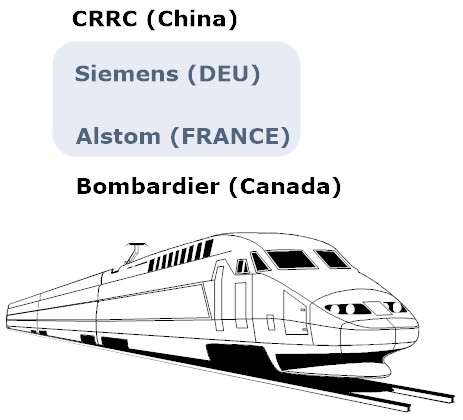
Volgens de 1M van Frankrijk, Edouard Philippe, moet de fusie leiden tot een grotere Europese rail-groep die moet kunnen opboksen tegen de concurrentie van China.
Commentaar: Ik zie niet in hoe een schaalvergroting een voordeel zou kunnen zijn, gegeven de significant lagere productiekosten in China. Het conglomeraat Siemens/Alstom wordt eerder een aantrekkelijker prooi voor de grote appetijt van de Chinese investeerders (of Big Players die zich voor Chinezen laten doorgaan). En dus is het best mogelijk dat Siemans/Alstom binnen enkele jaren opgeslokt wordt door het netwerk van de Big Players.
Hieronder het perspericht van Alstom, vrijgegeven op 26/9/2017.
Siemens and Alstom join forces to create a European Champion in Mobility
26/09/2017
Signed Memorandum of Understanding grants exclusivity to combine mobility businesses in a merger of equals
Listing in France and group headquarters in Paris area; led by Alstom CEO with 50 percent shares of the new entity owned by Siemens
Business headquarter for Mobility Solutions in Germany and for Rolling Stock in France
Comprehensive offering and global presence will offer best value to customers all over the world
Combined company’s revenue €15.3 billion, adjusted EBIT of €1.2 billion
Annual synergies of €470 million expected latest four years after closing
Today, Siemens and Alstom have signed a Memorandum of Understanding to combine Siemens’ mobility business including its rail traction drives business with Alstom. The transaction brings together two innovative players of the railway market with unique customer value and operational potential. The two businesses are largely complementary in terms of activities and geographies. Siemens will receive newly issued shares in the combined company representing 50 percent of Alstom’s share capital on a fully diluted basis.
“This Franco-German merger of equals sends a strong signal in many ways. We put the European idea to work and together with our friends at Alstom, we are creating a new European champion in the rail industry for the long term. This will give our customers around the world a more innovative and more competitive portfolio”, said Joe Kaeser, President and CEO of Siemens AG. “The global market-place has changed significantly over the last few years. A dominant player in Asia has changed global market dynamics and digitalization will impact the future of mobility. Together, we can offer more choices and will be driving this transformation for our customers, employees and shareholders in a responsible and sustainable way”, Kaeser added.
“Today is a key moment in Alstom’s history, confirming its position as the platform for the rail sector consolidation. Mobility is at the heart of today’s world challenges. Future modes of transportation are bound to be clean and competitive. Thanks to its global reach across all continents, its scale, its technological know-how and its unique positioning on digital transportation, the combination of Alstom and Siemens Mobility will bring to its customers and ultimately to all citizens smarter and more efficient systems to meet mobility challenges of cities and countries. By combining Siemens Mobility’s experienced teams, complementary geographies and innovative expertise with ours, the new entity will create value for customers, employees and shareholders,” said Henri Poupart-Lafarge, Chairman and Chief Executive Officer of Alstom SA. “I am particularly proud to lead the creation of such a group which will undoubtedly shape the future of mobility.”
The new entity will benefit from an order backlog of €61.2 billion, revenue of €15.3 billion, an adjusted EBIT of €1.2 billion and an adjusted EBIT-margin of 8.0 percent, based on information extracted from the last annual financial statements of Alstom and Siemens. In a combined setup, Siemens and Alstom expect to generate annual synergies of €470 million latest in year four post-closing and targets net-cash at closing between €0.5 billion to €1.0 billion. Global headquarters as well as the management team for rolling stock will be located in Paris area and the combined entity will remain listed in France. Headquarters for the Mobility Solutions business will be located in Berlin, Germany. In total, the new entity will have 62,300 employees in over 60 countries.
As part of the combination, Alstom existing shareholders at the close of the day preceding the closing date, will receive two special dividends: a control premium of €4.00 per share (in total = €0.9 billion) to be paid shortly after closing of the transaction and an extraordinary dividend of up to €4.00 per share (in total = €0.9 billion) to be paid out of the proceeds of Alstom’s put options for the General Electric joint ventures of approximately €2.5 billion subject to the cash position of Alstom. Siemens will receive warrants allowing it to acquire Alstom shares representing two percentage points of its share capital that can be exercised earliest four years after closing.
The businesses of the two companies are largely complementary. The combined entity will offer a significantly increased range of diversified product and solution offerings to meet multi-facetted, customer-specific needs, from cost-efficient mass-market platforms to high-end technologies. The global footprint enables the merged company to access growth markets in Middle East and Africa, India, and Middle and South America where Alstom is present, and China, United States and Russia where Siemens is present. Customers will significantly benefit from a well-balanced larger geographic footprint, a comprehensive portfolio offering and significant investment into digital services. The combination of know-how and innovation power of both companies will drive crucial innovations, cost efficiency and faster response, which will allow the combined entity to better address customer needs.
The Board of Directors of the combined group will consist of 11 members and will be comprised of 6 directors designated by Siemens, one of which being the Chairman, 4 independent directors and the CEO. In order to ensure management continuity, Henri Poupart-Lafarge, will continue to lead the company as CEO and will be a board member. Jochen Eickholt, CEO of Siemens Mobility, shall assume an important responsibility in the merged entity. The corporate name of the combined group will be Siemens Alstom.
The envisaged transaction is unanimously supported by Alstom’s board (further to a review process of the preparation of the transaction by the Audit Committee acting as an ad hoc committee) and Siemens’s supervisory board. Bouygues fully supports the transaction and will vote in favor of the transaction at the Alstom’s board of directors and at the extraordinary general meeting deciding on the transaction to be held before July 31, 2018, in line with Alstom board of director decision. The French State also supports the transaction based on undertakings by Siemens, including a standstill at 50.5 percent of Alstom’s share capital for four years after closing and certain governance and organizational and employment protections. The French State confirms that the loan of Alstom shares from Bouygues SA will be terminated in accordance with its terms no later than October 17, 2017 and that it will not exercise the options granted by Bouygues. Bouygues has committed to keep its shares until the earlier of the extraordinary general meeting deciding on the transaction and July 31, 2018.
In France, Alstom and Siemens will initiate Works Councils’ information and consultation procedure according to French law prior to the signing of the transaction documents. If Alstom were not to pursue the transaction, it would have to pay a €140 million break-fee. The transaction will take the form of a contribution in kind of the Siemens Mobility business including its rail traction drives business to Alstom for newly issued shares of Alstom and will be subject to Alstom’s shareholders’ approval, including for purposes of cancelling the double voting rights, anticipated to be held in the second quarter of 2018. The transaction is also subject to clearance from relevant regulatory authorities, including foreign investment clearance in France and anti-trust authorities as well as the confirmation by the French capital market authority (AMF) that no mandatory takeover offer has to be launched by Siemens following completion of the contribution. Closing is expected at the end of calendar year 2018.
de geschiedenis van Siemens
histoire d'Alstom France

The German Foreign Ministry and the Dictatorships
ID: 201604257866
Better late than never: German Foreign Minister Frank-Walter Steinmeier is planning to make a statement this week on his office’s handling of the criminal sect Colonia Dignidad, a German settlement located in a huge compound in Chile. From 1961 on the group’s founder and leader Paul Schäfer was involved in drugging residents and the rape of children from the sect and the neighboring villages. After 1973, the Colonia collaborated with the Pinochet dictatorship to run a torture prison for opponents of the regime. Steinmeier’s announcement raises high expectations. In 2010 the German foreign ministry set high standards with its historical work “The Ministry and the past. German diplomats in the Third Reich and in the Federal Republic” (Das Amt und die Vergangenheit. Deutsche Diplomaten im Dritten Reich und in der Bundesrepublik). At the instigation of the Foreign Minister at the time, Joschka Fischer, a commission of academics researched not only the role of the foreign ministry in the Nazi system, but also the continuity of personnel and ideology within the fledgling Federal Republic of Germany. I would have wished for one short extra chapter: German diplomacy during the Argentine and Chilean military dictatorships. There would have been plenty of grounds for it. In February 1976, shortly before the military putsch, the German ambassador in Buenos Aires Jörg Kastl recommended that Germany “work together with the new regime” and later stressed Argentina’s importance as a “cornerstone of the expanded transatlantic security framework, a market and source of raw materials, home of many German settlers and German assets, and ever a true friend to our Volk”. Cold war mentality in its purest form: global communism as the enemy that must be fought by any means. Around the same time, the Pinochet regime was more or less publicly torturing people at the national stadium in Santiago de Chile. In Argentina it was done in secret, but the abductions and torture, including of German citizens, after the military seized power were well known around the world – again, including here in Germany. Yet German diplomats did scandalously little and even helped the military to spread their lies, as in the case of German woman Elisabeth Käsemann. Käsemann was tortured in the secret detention center El Vesubio and subsequently murdered. To cover it up the junta made it look like she had died in combat. The military placed weapons beside her body, and the bodies of other dead prisoners, to make them look like guerrilla fighters. German diplomats visited the torture and rape colony Colonia Dignidad several times from the mid 1960s on. And yet they didn’t intervene, as they were obliged to do, until well into the 1980s, despite being familiar with the witness testimonies of escaped former residents and the reports on the torture from Amnesty International. The few people who managed to leave the colony got no help from the embassy; in fact, the embassy handed them back to the Colonia leadership, who brutally punished anyone who tried to flee. Even after Hartmut Hopp, the sect’s doctor and Schäfer’s right-hand man, faced torture allegations before a human rights commission at the German parliament in 1988, the prosecutor’s office in Bonn didn’t feel the need to seriously examine the role played by the Germans in Chile. In the meantime, prosecutors in Krefeld started investigations against Hopp after he dodged a sentence handed down to him in Chile. A court in Chile sentenced him to five years in prison for aiding and abetting the sexual abuse of minors but Hopp fled to Germany before serving the time. But Germany’s role in the dictatorships in Chile and Argentina is not just a matter of failures on the part of the foreign ministry. Other entities also played a role. German industry made weapons and nuclear deals with the dictatorships. Mercedes Benz helped to “disappear” trade unionists who stood in their way. Meanwhile, the regime’s henchmen were given a red carpet welcome in Germany, and officers were provided with training in weapons techniques. Bigwigs from the CSU party gave their unwritten support to the dictatorships. And most of the German public looked the other way. So, better late than never: a thorough investigation is needed into the actions of German diplomats, as well as the intelligence services and the defense ministry, during the dictatorships in Chile and Argentina. The victims must be compensated. And then there must be other consequences: disciplinary consequences, criminal proceedings, and where still possible, political consequences, in order to ensure that in future, human rights are respected in foreign politics. One final note: between 1974 and 1992 the German foreign ministry was led by Hans-Dietrich Genscher, who was recently honored in a German state ceremony.
Land: ARG

The Forgotten European Slaves of Barbary North Africa and Ottoman Turkey
ID: 201511081161
Gepubliceerd op 8 nov. 2015
Ohio State University history Professor Robert Davis describes the White Slave Trade as minimized by most modern historians in his book Christian Slaves, Muslim Masters: White Slavery in the Mediterranean, the Barbary Coast and Italy, 1500–1800 (Palgrave Macmillan). Davis estimates that 1 million to 1.25 million white Christian Europeans were enslaved in North Africa, from the beginning of the 16th century to the middle of the 18th, by slave traders from Tunis, Algiers, and Tripoli alone (these numbers do not include the European people which were enslaved by Morocco and by other raiders and traders of the Mediterranean Sea coast), 16th- and 17th-century customs statistics suggest that Istanbul's additional slave import from the Black Sea may have totaled around 2.5 million from 1450 to 1700. The markets declined after the loss of the Barbary Wars and finally ended in the 1830s, when the region was conquered by France.
Hundreds of thousands of Europeans were captured by Barbary pirates and sold as slaves in North Africa and the Ottoman Empire between the 16th and 19th centuries. These slave raids were conducted largely by Arabs and Berbers rather than Ottoman Turks. However, during the height of the Barbary slave trade in the 16th and 17th centuries, the Barbary states were subject to Ottoman jurisdiction and ruled by Ottoman pashas. Furthermore, many slaves captured by the Barbary corsairs were sold eastward into Ottoman territories before, during, and after Barbary's period of Ottoman rule.
The Barbary Muslim pirates kidnapped Europeans from ships in North Africa’s coastal waters (Barbary Coast). They also attacked and pillaged the Atlantic coastal fishing villages and town in Europe, enslaving the inhabitants. Villages and towns on the coast of Italy, Spain, Portugal and France were the hardest hit. Muslim slave-raiders also seized people as far afield as Britain, Ireland and Iceland.
In 1544, the island of Ischia off Naples was ransacked, taking 4,000 inhabitants prisoners, while some 9,000 inhabitants of Lipari Island off the north coast of Sicily were enslaved.870 Turgut Reis, a Turkish pirate chief, ransacked the coastal settlements of Granada (Spain) in 1663 and carried away 4,000 people as slaves. In 1625, Barbary pirates captured the Lund Island in the Bristol Channel and planted the standard of Islam. From this base, they went ransacking and pillaging surrounding villages and towns, causing a stunning spectacle of mayhem, slaughter and plunder. According to Milton, ‘Day after day, they struck at unarmed fishing communities, seizing the inhabitants, and burning their homes. By the end of the dreadful summer of 1625, the mayor of Plymouth reckoned that 1,000 skiffs had been destroyed and similar number of villagers carried off into slavery.’871 Between 1609 and 1616, the Barbary pirates ‘captured a staggering 466 English trading ships.’
In 1627, Pirates went on a pillaging and enslaving campaign to Iceland. After dropping anchor at Reykjavik, his forces ransacked the town and returned with 400 men, women and children and sold them in Algiers. In 1631, he made a voyage with a brigand of 200 pirates to the coast of Southern Ireland and ransacked and pillaged the village of Baltimore, carrying away 237 men, women and children to Algiers.
The barbaric slave-raiding activities of the Muslim pirates had a telling effect on Europe. France, England, and Spain lost thousands of ships, devastating to their sea-borne trade. Long stretches of the coast in Spain and Italy were almost completely abandoned by their inhabitants until the nineteenth century. The finishing industry was virtually devastated.
Paul Baepler’s White Slaves, African Masters: An Anthology of American Barbary Captivity Narratives lists a collection of essays by nine American captives held in North Africa. According to his book, there were more than 20,000 white Christian slaves by 1620 in Algiers alone; their number swelled to more than 30,000 men and 2,000 women by the 1630s. There were a minimum of 25,000 white slaves at any time in Sultan Moulay Ismail’s palace, records Ahmed ez-Zayyani; Algiers maintained a population of 25,000 white slaves between 1550 and 1730, and their numbers could double at certain times. During the same period, Tunis and Tripoli each maintained a white slave population of about 7,500. The Barbary pirates enslaved some 5,000 Europeans annually over a period of nearly three centuries.

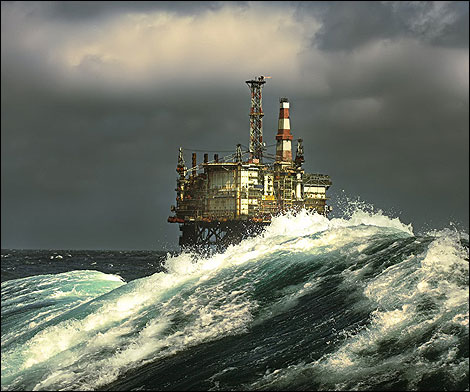
Britain's North Sea Oil and Gas Firms must Look to Future Abroad: Kemp
ID: 201503130901
Published in on Friday, 13 March 2015
The North Sea has already produced 42 billion barrels of oil and gas, but could have as much as 24 billion barrels left, according to FT columnist Nick Butler (“Don’t abandon the North Sea” Feb 22).
For North Sea operators and their supporters, the remaining reserves provide a compelling economic reason to keep producing to avoid leaving value locked in the ground.
The reserves represent tens of billions of dollars in profits, wages and tax revenues that would be lost if the North Sea fields are abandoned prematurely.
North Sea reserves have a strong political dimension because most operators and service companies are based in Scotland, where separatist sentiment remains strong despite the rejection of independence in last year’s referendum.
The economic reality is more complicated. The notional value of the oil and gas that would remain locked in the ground is not a convincing reason why it should be developed. In a market-based economy, resources are developed only if they can be extracted profitably.
And there are many instances where resources have been left in the ground or abandoned because it was no longer possible to exploit them profitably.
The distinction between exhaustion and profitability was central to the year-long dispute between the National Union Mineworkers (NUM) and the Conservative government led by Margaret Thatcher, the defining moment in Britain’s modern economic history.
In the early 1980s, Britain’s state-owned coal company wanted to close mines that were no longer profitable while the NUM resolved “to re-affirm the union’s opposition to all pit closures other than on grounds of exhaustion.”
The NUM demanded that pits remain open as a source of employment and national energy security as long as there was valuable coal underground (“Crisis management in the power industry” 1995).
Ironically, coal’s nemesis came from the giant gas fields found in the North Sea between the 1950s and 1970s, which threatened coal’s dominance in power generation (“Energy, the State and the Market” 2003).
Once the government’s support for coal was removed after the strike was broken, construction of coal-fired power plants ended and power producers raced to build cheaper gas-fired facilities to capitalize on the cheaper fuel.
By the end of the 1990s, nearly all of Britain’s pits had closed, although there were still billions of tonnes of coal left underground. Twenty years later, Britain’s gas supplies are dwindling, and the country increasingly relies on imported gas from overseas, raising concerns about “energy security”.
If energy security had been the clinching argument, the government would have intervened to keep more pits open. Instead, Britain chose a market-based approach. There is no reason why North Sea oil and gas producers should be treated any differently.
UNFAVORABLE CONDITIONS
Britain’s oil and gas producers are among the victims of the North American shale revolution and the price war between OPEC and the U.S. shale industry.
Like Canada’s oil sands industry, which is also suffering, the North Sea is a relatively expensive source of oil and gas. In recent years, its prospects have depended on oil and gas remaining scarce and prices remaining high.
The North Sea must compete for investment with other oil and gas plays around the world. Before the shale revolution North Sea oil and gas appeared marginally profitable. But with oil prices now around $60 per barrel and widely expected to remain well below $100 for the next few years, the North Sea is no longer an attractive investment proposition.
UK operators tend to blame their problems on the tax regime, which they claim is more punitive and complicated than in other parts of the world. While there is some truth in this argument, the tax regime’s complexity is the legacy of government efforts to clamp down on previous tax avoidance.
In any event, the UK North Sea’s problems run much deeper than tax. Offshore platforms in a notoriously stormy area are a more expensive way to produce oil and gas than onshore shale plays in the United States.
The giant oil and gas fields discovered in the 1960s, 1970s and 1980s could spread the fixed costs of platforms, pipelines and other infrastructure over a large volume of production. Recent field discoveries have been much smaller and have no such economies of scale.
Recent discoveries can only be profitable if they can utilize the existing infrastructure. The problem is that the infrastructure isn’t free and it isn’t public property: it belongs to existing operators, most of them major oil and gas companies, who have a legal obligation to decommission it.
If the infrastructure’s life is to be extended and decommissioning is to be deferred, money will have to be found for routine maintenance as well as capital upgrades.
There is a standoff between the would-be operators of small-scale new fields (who want the infrastructure to be preserved but don’t want to pay high fees) and the bigger legacy operators (who want to get on with decommissioning or charge significant fees to maintain the infrastructure for longer).
The dispute is often caricatured as a disagreement between entrepreneurial operators and stubborn greedy majors. In truth, it is a dispute about the costs of prolonging the life of the infrastructure and who should pay for them.
In a world where oil and gas were thought to be running out and prices were expected to keep on rising, it might have made sense to extend the useful life of the North Sea infrastructure. In a world of $60 oil, the economics are much more challenging.
Over the last 50 years, Britain has developed world-class expertise in offshore oil and gas engineering, which supports thousands of highly skilled jobs, and it would be a shame to lose it. But the industry’s future increasingly lies in selling that expertise abroad, rather than developing the North Sea itself.
Source - www.reuters.com
The North Sea has already produced 42 billion barrels of oil and gas, but could have as much as 24 billion barrels left, according to FT columnist Nick Butler (“Don’t abandon the North Sea” Feb 22).
For North Sea operators and their supporters, the remaining reserves provide a compelling economic reason to keep producing to avoid leaving value locked in the ground.
The reserves represent tens of billions of dollars in profits, wages and tax revenues that would be lost if the North Sea fields are abandoned prematurely.
North Sea reserves have a strong political dimension because most operators and service companies are based in Scotland, where separatist sentiment remains strong despite the rejection of independence in last year’s referendum.
The economic reality is more complicated. The notional value of the oil and gas that would remain locked in the ground is not a convincing reason why it should be developed. In a market-based economy, resources are developed only if they can be extracted profitably.
And there are many instances where resources have been left in the ground or abandoned because it was no longer possible to exploit them profitably.
The distinction between exhaustion and profitability was central to the year-long dispute between the National Union Mineworkers (NUM) and the Conservative government led by Margaret Thatcher, the defining moment in Britain’s modern economic history.
In the early 1980s, Britain’s state-owned coal company wanted to close mines that were no longer profitable while the NUM resolved “to re-affirm the union’s opposition to all pit closures other than on grounds of exhaustion.”
The NUM demanded that pits remain open as a source of employment and national energy security as long as there was valuable coal underground (“Crisis management in the power industry” 1995).
Ironically, coal’s nemesis came from the giant gas fields found in the North Sea between the 1950s and 1970s, which threatened coal’s dominance in power generation (“Energy, the State and the Market” 2003).
Once the government’s support for coal was removed after the strike was broken, construction of coal-fired power plants ended and power producers raced to build cheaper gas-fired facilities to capitalize on the cheaper fuel.
By the end of the 1990s, nearly all of Britain’s pits had closed, although there were still billions of tonnes of coal left underground. Twenty years later, Britain’s gas supplies are dwindling, and the country increasingly relies on imported gas from overseas, raising concerns about “energy security”.
If energy security had been the clinching argument, the government would have intervened to keep more pits open. Instead, Britain chose a market-based approach. There is no reason why North Sea oil and gas producers should be treated any differently.
UNFAVORABLE CONDITIONS
Britain’s oil and gas producers are among the victims of the North American shale revolution and the price war between OPEC and the U.S. shale industry.
Like Canada’s oil sands industry, which is also suffering, the North Sea is a relatively expensive source of oil and gas. In recent years, its prospects have depended on oil and gas remaining scarce and prices remaining high.
The North Sea must compete for investment with other oil and gas plays around the world. Before the shale revolution North Sea oil and gas appeared marginally profitable. But with oil prices now around $60 per barrel and widely expected to remain well below $100 for the next few years, the North Sea is no longer an attractive investment proposition.
UK operators tend to blame their problems on the tax regime, which they claim is more punitive and complicated than in other parts of the world. While there is some truth in this argument, the tax regime’s complexity is the legacy of government efforts to clamp down on previous tax avoidance.
In any event, the UK North Sea’s problems run much deeper than tax. Offshore platforms in a notoriously stormy area are a more expensive way to produce oil and gas than onshore shale plays in the United States.
The giant oil and gas fields discovered in the 1960s, 1970s and 1980s could spread the fixed costs of platforms, pipelines and other infrastructure over a large volume of production. Recent field discoveries have been much smaller and have no such economies of scale.
Recent discoveries can only be profitable if they can utilize the existing infrastructure. The problem is that the infrastructure isn’t free and it isn’t public property: it belongs to existing operators, most of them major oil and gas companies, who have a legal obligation to decommission it.
If the infrastructure’s life is to be extended and decommissioning is to be deferred, money will have to be found for routine maintenance as well as capital upgrades.
There is a standoff between the would-be operators of small-scale new fields (who want the infrastructure to be preserved but don’t want to pay high fees) and the bigger legacy operators (who want to get on with decommissioning or charge significant fees to maintain the infrastructure for longer).
The dispute is often caricatured as a disagreement between entrepreneurial operators and stubborn greedy majors. In truth, it is a dispute about the costs of prolonging the life of the infrastructure and who should pay for them.
In a world where oil and gas were thought to be running out and prices were expected to keep on rising, it might have made sense to extend the useful life of the North Sea infrastructure. In a world of $60 oil, the economics are much more challenging.
Over the last 50 years, Britain has developed world-class expertise in offshore oil and gas engineering, which supports thousands of highly skilled jobs, and it would be a shame to lose it. But the industry’s future increasingly lies in selling that expertise abroad, rather than developing the North Sea itself.
Source - www.reuters.com

The Mineral Industry of Congo (Kinshasa)
ID: 201501231378
Land: COD

how value tends toward infinity
ID: 201411180146
"I used to say in the cable industry that if your interest rate was lower than your growth rate, your present value is infinite. That’s why the cable industry created so many rich guys. It was the combination of tax-sheltered cash-flow growth that was, in effect, growing faster than the interest rate under which you could borrow money. If you do any arithmetic at all, the present value calculation tends toward infinity under that thesis."

Niet normaal
ID: 201411072334
Mogen we niet verwachten dat de captains of industry en de rijke adellijke families het goede voorbeeld geven? Hoe geloofwaardig is liefdadigheid nog van mensen of bedrijven die alles doen om zo veel mogelijk belastingen ontwijken? Het kan toch niet 'normaal' zijn dat bedrijven of families die de beste fiscale experts rond zich kunnen verzamelen, ongrijpbaar zijn voor de Belgische fiscus. De belastinginspecteur die straks het kluwen, geweven door de beste fiscaal advocaten van het land, mag ontwarren, is te beklagen.

The Most Prestigious Consulting Firms (2011)
ID: 201404302109
Vault.com, the career website, released a ranking today of the most prestigious consulting firms. A little like the Oscars, which turns to the movie industry to tally its votes, Vault’s list comes from a survey of consultants who are asked to rank their peers and competitors. Vault ran its survey from March through July 2011 and gathered votes from 5,000 consultants at 60 firms, ranging from giant companies like McKinsey and Bain to small outfits like Bates White in Washington, D.C.
For the prestige ranking, consultants were not allowed to vote for their own firms, and they were asked only to rate firms with which they were familiar. Vault has been running the survey for a decade, and every year McKinsey has come out on top. In fact, the top five are unchanged from last year, though PricewaterhouseCoopers moved up two spots to #6, Ernst & Young climbed one spot to #8 and Mercer LLC fell three spots to #9. Herewith, the top ten:
1. McKinsey & Company
2. The Boston Consulting Group
3. Bain & Company
4. Booz & Company
5. Deloitte Consulting
6. PricewaterhouseCoopers
7. Monitor Group
8. Ernst & Young
9. Mercer LLC
10. Accenture
For the prestige ranking, consultants were not allowed to vote for their own firms, and they were asked only to rate firms with which they were familiar. Vault has been running the survey for a decade, and every year McKinsey has come out on top. In fact, the top five are unchanged from last year, though PricewaterhouseCoopers moved up two spots to #6, Ernst & Young climbed one spot to #8 and Mercer LLC fell three spots to #9. Herewith, the top ten:
1. McKinsey & Company
2. The Boston Consulting Group
3. Bain & Company
4. Booz & Company
5. Deloitte Consulting
6. PricewaterhouseCoopers
7. Monitor Group
8. Ernst & Young
9. Mercer LLC
10. Accenture
Land: INT

FranceAfrique 1+2
ID: 201301302388
Vooral de naam van Robert Bourgi - die Foccart als mentor had - is belangrijk als go between tussen het Elysée en de Afrikaanse staten. Hij werd ingeschakeld door Nicolas Sarkozy.
Te onthouden: vanaf 2000 nemen de captains of industry het over van het Elysée.
Te onthouden: Nigeria heeft uranium.
De grote rol van Gabon en president Omar Bongo in de Franse (sic!) politiek.
In 1994 ontploft de affaire ELF; de onderzoeksrechter is Eva Joly.
De rol van BIDERMANN Textiles in de affaire ELF.
In 1997 sterft Foccart.
Te onthouden: de meeste presidenten van de FranceAfrique behoren tot de loge.
Onthoudt ook de naam van Vincent Bolloré.
L'espace « françafricain »
Afrique francophone. Population de 363 millions en 201312. Population prévue entre 785 millions13 et 814 millions12 en 2050.
14,15
Pays considérés comme francophones
Pays non francophones mais membres ou Observateurs de l'OIF
Les pays considérés comme appartenant à des degrés divers à la « Françafrique » sont les anciennes colonies françaises en Afrique subsaharienne, à savoir :
En Afrique de l'Ouest : Sénégal, Côte d'Ivoire, Burkina Faso, Togo, Bénin, Niger, Mali
En Afrique centrale : République du Congo, Gabon, Tchad, République centrafricaine, Cameroun
Dans l'océan Indien et la corne de l'Afrique : Comores, Madagascar, Djibouti
Land: GAB

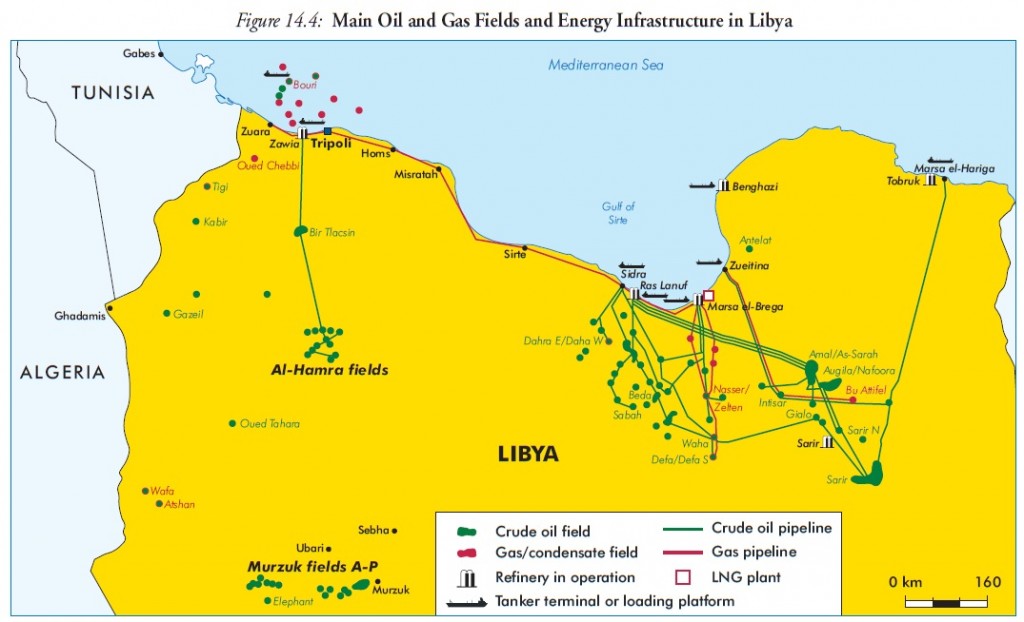
History of Libyan oil 1955-2008
ID: 201102230901
Libya produced 1.65 mb/d of crude oil in Oct. 2010 and exported 1.2 mb/d crude in 2008. Both crude production and exports have recently peaked.
Libya is a maturing oil province in which 27 Gb have been produced, out of an estimated ultimate of 40-60 Gb. Therefore, the depletion midpoint has been reached or will be reached in this decade. Due to the low population (6.5 million) and a local consumption of petroleum products of just 250 kb/d Libya will remain an oil exporter for a long time to come even when taking into account population growth and higher per capita consumption rates. However, we do not know to which extent the current unrest will impact on future oil production.
History of Libyan oil:
1955: Petroleum Law, entry of British and American oil companies
1957: First oil discovery: light crude in Zelten, Sirte basin
1959: Discoveries: Amal 4.5 Gb, Beda 1 Gb, Nasser 1 Gb
1961: BP finds remote giant Serir field, 5 Gb
1960: Discovery Defa 2 Gb
1961: Discovery Gialo 3.5 Gb, Sarir 6 Gb, Waha 1 Gb
1962: Libya joins OPEC
1965: Discovery Augila-Nafoora 2 Gb
1967: Discovery Intisar 2.25 Gb
1967: Libyan oil gains strategic importance after 6-day war
1968: Discovery Bu Attifel 1.5 Gb
1969: King Idris ousted by Colonel Gaddafi
1970: Oil production peak at 3.3 mb/d
1970s: Nationalisation of oil industry results in production decline
1973: OPEC embargo on oil exports
1977: War with Egypt
1978: War with Chad starts (Aouzou strip, until 1987)
1980s: OPEC quotas introduced, quota is now 1.5 mb/d
1986: US aerial attack
1988: Pan Am explodes over Lockerbie
1993: UN sanctions banning import of refinery equipment,
1996: US trade sanctions
2002: Oil output increased due to an international re-orientation
2004: Tony Blair shakes hands with Gaddafi, US sanctions lifted
2008: Libya-Italy friendship treaty ($5 bn compensation from Italy for colonial occupation)
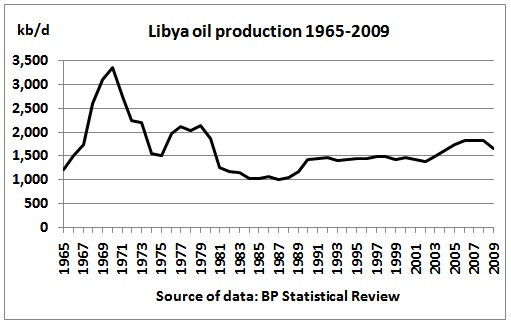
Libya is a maturing oil province in which 27 Gb have been produced, out of an estimated ultimate of 40-60 Gb. Therefore, the depletion midpoint has been reached or will be reached in this decade. Due to the low population (6.5 million) and a local consumption of petroleum products of just 250 kb/d Libya will remain an oil exporter for a long time to come even when taking into account population growth and higher per capita consumption rates. However, we do not know to which extent the current unrest will impact on future oil production.
History of Libyan oil:
1955: Petroleum Law, entry of British and American oil companies
1957: First oil discovery: light crude in Zelten, Sirte basin
1959: Discoveries: Amal 4.5 Gb, Beda 1 Gb, Nasser 1 Gb
1961: BP finds remote giant Serir field, 5 Gb
1960: Discovery Defa 2 Gb
1961: Discovery Gialo 3.5 Gb, Sarir 6 Gb, Waha 1 Gb
1962: Libya joins OPEC
1965: Discovery Augila-Nafoora 2 Gb
1967: Discovery Intisar 2.25 Gb
1967: Libyan oil gains strategic importance after 6-day war
1968: Discovery Bu Attifel 1.5 Gb
1969: King Idris ousted by Colonel Gaddafi
1970: Oil production peak at 3.3 mb/d
1970s: Nationalisation of oil industry results in production decline
1973: OPEC embargo on oil exports
1977: War with Egypt
1978: War with Chad starts (Aouzou strip, until 1987)
1980s: OPEC quotas introduced, quota is now 1.5 mb/d
1986: US aerial attack
1988: Pan Am explodes over Lockerbie
1993: UN sanctions banning import of refinery equipment,
1996: US trade sanctions
2002: Oil output increased due to an international re-orientation
2004: Tony Blair shakes hands with Gaddafi, US sanctions lifted
2008: Libya-Italy friendship treaty ($5 bn compensation from Italy for colonial occupation)

Land: LBY

opstand en rassenrellen in Los Angeles
ID: 199204291465
Los Angeles Riots 10 Years Later and the Likelyhood of Another Revolt
By Alejandro A. Alonso
Streetgangs.com Magazine
Los Angeles - Historians of the Black Urban experience have concentrated on New York and Chicago, tending to ignore the nation's second largest city, Los Angeles, yet the events in 1965 and 1992, the evolution of gangster rap music, the proliferation of gangs, sensational trials, and the growth of various forms of nationalism suggest that LA is a city worthy of deeper investigation. Gerald Horne was absolutely correct and several of these phenomena continue to shape and define Los Angeles in the 21st Century, such as the Rampart police investigation, the ouster of Chief of Police Bernard Parks, a recent significant increase in violence, and the upcoming trial of Robert Blake that will prove to have many eyes on LA for several weeks, but is the potential for another riot there?
Those of us old enough to remember August 1965, on that hot summer day when Marquette Frye was arrested for driving under the influence know how easy and how quickly a small protest can escalate into a full blown riot. The Watts riot surpassed all the riots of 1964 that occurred in New York City, Rochester, Jersey City, Paterson, Elizabeth, Chicago, and Philadelphia in loss of life, injuries, arrests, and structures damaged. National Guards men were called in, and six days later, on August 16, 1965 the revolt came to an end. It would take two massive strikes by Blacks during 1967 in Newark, and Detroit to overshadow the Watts Riots, but it would still remain a significant episode in the Black Revolution of the 1960s, as it became the focus of several analysis and studies. Also what made the situation in Watts and Los Angeles so perplexing was that Blacks in Los Angeles were ranked first among sixty-eight cities in quality of life. In 1964, an Urban League study analyzing aspects of life among Los Angeles Blacks stated that housing, employment, and income were highly ranked compared to other cities for Blacks.
Twenty-seven years later, civil unrest would revisit Los Angeles, and once again earn its place in history as the worst urban revolt in American history. On April 29, 1992, following the not guilty verdicts of four Los Angeles Police Officers accused of beating motorist Rodney King, violence erupted at the intersection of Florence and Normandie in South Los Angeles. At the same time, individuals at the corner of 67th Street and 11th Avenue were revolting against passer-bys and motorists. Black residents were outraged that four LAPD officers received not guilty verdicts from an all white jury in Simi Valley, despite the videotape evidence of the beating of Rodney King, and the testimonial by veteran police officers on behalf of the prosecution. From April 29, 1992 at approximately 3:30 p.m. until May 1st, the violence raged on. The National Guard were called in to bring calm to the city, and by Friday afternoon the violence and looting were subdued. The most violent urban revolt that the United States had ever experienced in the twentieth century resulted in 52 deaths, 2,499 injuries, 6,559 arrests, 1,120 building damaged, 2,314 stores damaged and close to 1 billion in damages.
The following day on Saturday, May 2, 1992, Pete Ueberroth accepted Mayor Tom Bradley's appointment to head the newly formed non-profit organization dubbed Rebuild L.A to revitalize the ravaged sections of Los Angeles. He vowed to create sustainable jobs in South Los Angeles by getting corporations to make long-term commitments to the damaged areas. This organization was described by the mayor's office as an "extra-governmental task force" to rebuild Los Angeles, and if successful, transform neighborhoods known for providing service sector jobs to areas of industry and manufacturing, utilizing trained workers. Unfortunately RLA fell short many of it goals and Pete Ueberroth, who was magical in producing a major profit from the 1984 Olympics in Los Angeles was not able to foster the relationships and convince enough investors into South LA and he soon resigned from his post.
So is Los Angeles a more sustainable place for racial minorities to live today and does the potential for a riot loom in the near future? According to a recent poll, about 50% of those in Los Angeles believe that another riot could occur within several years, and those that claim a riot is inevitable point to the lack of economic stability in South Los Angeles as being the major reason why a riot can occur again. Magic Johnson's investments into Los Angeles are considered great efforts to build the community, especially his theater on Martin Luther King Jr. Avenue in South LA, but black activists claim that coffee shops are not enough. If you look around Los Angeles and gage economic transformations in various places it is not difficult to see that South Los Angeles has received little attention from business and investors. In the last 10 years, areas that have seen major transformations in terms of economic development and business investment include Downtown Los Angeles, Hollywood Blvd, Universal City and Pasadena.
I believe that investors need to be convincingly sold on the idea of South LA and that there are millions of dollars that can be spent in South LA. Are these attempts being made or are there attempts by so called leaders of the community stagnating and preventing these types of investments to occur? Office Depot, Target, Home Depot, and Starbucks are a few of the new retailers that are present in some of the exact places where the riots damaged property in 1992 and investors such as Magic Johnson definitely help, but the discussion on economics does not address the issue of the potential of another riot occurring in Los Angeles.
If we go back to 1992 and examine the precipitating factor of the riot, economics actually played a small role influencing the revolt. Yes, there was a recession in Los Angeles and around the country, unemployment was at an all time high, high levels of poverty probably exacerbated the riots that took place, but the critical events and underlying factors to the revolt were the beating of Rodney King in 1991, the probation sentence handed down on Sun Ja Doo, a Korean store clerk that shot Latasha Harlins, a 15 year old black girl, in the back of the head after a dispute over orange juice, and the acquittal of the four LAPD officers. In the Sun Ja Doo incident the jury came back with a second-degree murder conviction, but Judge Joyce Karlin, a white woman, did the unheard of when she sentenced Doo to five years probation. This is what I believe paved the way for the worst urban riot in contemporary history and the fact that over 50% of the damaged or destroyed property was Korean owned was no accident, and is the reason why many characterize this event as an uprising or a revolt. Although many of the images captured certainly show those acting as opportunists taking advantage of an unfortuate situation, at the same time there was an organized attack against Korean establishments within South LA and outside of the black community along Vermont and Western Avenues, north of the black community. Relations between blacks and Koreans in Los Angeles have often been full of tension and there is housing evidence that suggests that those tensions are still present in 2002.
The critical factors that influenced the events of April 29, 1992 all took place within the criminal justice sector of society with the police department central to the events. This is were we must look to address the question of a potential third Los Angeles riot. Chief Daryl Gates was held accountable for the type of relationship that was created between the police and minority communities in South LA and his response to the first day of the riot was considered dismal. Also let us not forget history, when in 1965 people took to the streets of Los Angeles in protest the day following alleged police abuses after the arrest of a Marquette Frye on 116th Street and Avalon. Chief William Parker was also highly criticized for the sharp divide that was created between the black community and the militaristic police, and resentment towards the police grew worse every year since Parker took over as Chief in 1950 up until the violence erupted in 1965. One indication of the increasing tension between the police and the community was the number of complaints that blacks filed between 1950 and 1965. Parker claimed no responsibility during a commission and when asked what sparked the riot he replied "someone threw a rock, and like monkeys in a zoo, they all started throwing rocks."
All of the seven race riots of 1964 were also sparked by an incident of police misconduct. The Otto Kerner Commission of 1968 stated that police actions led to outbreaks in half of the cases studied and those that believe that another revolt will take place will need to examine law enforcement and the criminal justice system. If the LAPD of LASD engage in any inappropriate activity such as excessive force or unlawful officer involved shootings, an outbreak of violence is definitely possible. Let us not forget what happened in Cincinnati in April 2001 when the shooting death of Timothy Thomas, 19, whose death touched off three days of riots. Cincinnati police officer Steven Roach was later found not guilty of negligent homicide in the shooting, but these are the types of events that will determine if Los Angeles will see part three. Under Bernard Parks inappropriate activity from the rank and file was highly unlikely with the disciplinary system that he had in place, but the actions of the next police chief may determine if what happened in 1965 and 1992 will occur again.
http://www.streetgangs.com/topics/2002/042902tenyearslater.html (20030905)
By Alejandro A. Alonso
Streetgangs.com Magazine
Los Angeles - Historians of the Black Urban experience have concentrated on New York and Chicago, tending to ignore the nation's second largest city, Los Angeles, yet the events in 1965 and 1992, the evolution of gangster rap music, the proliferation of gangs, sensational trials, and the growth of various forms of nationalism suggest that LA is a city worthy of deeper investigation. Gerald Horne was absolutely correct and several of these phenomena continue to shape and define Los Angeles in the 21st Century, such as the Rampart police investigation, the ouster of Chief of Police Bernard Parks, a recent significant increase in violence, and the upcoming trial of Robert Blake that will prove to have many eyes on LA for several weeks, but is the potential for another riot there?
Those of us old enough to remember August 1965, on that hot summer day when Marquette Frye was arrested for driving under the influence know how easy and how quickly a small protest can escalate into a full blown riot. The Watts riot surpassed all the riots of 1964 that occurred in New York City, Rochester, Jersey City, Paterson, Elizabeth, Chicago, and Philadelphia in loss of life, injuries, arrests, and structures damaged. National Guards men were called in, and six days later, on August 16, 1965 the revolt came to an end. It would take two massive strikes by Blacks during 1967 in Newark, and Detroit to overshadow the Watts Riots, but it would still remain a significant episode in the Black Revolution of the 1960s, as it became the focus of several analysis and studies. Also what made the situation in Watts and Los Angeles so perplexing was that Blacks in Los Angeles were ranked first among sixty-eight cities in quality of life. In 1964, an Urban League study analyzing aspects of life among Los Angeles Blacks stated that housing, employment, and income were highly ranked compared to other cities for Blacks.
Twenty-seven years later, civil unrest would revisit Los Angeles, and once again earn its place in history as the worst urban revolt in American history. On April 29, 1992, following the not guilty verdicts of four Los Angeles Police Officers accused of beating motorist Rodney King, violence erupted at the intersection of Florence and Normandie in South Los Angeles. At the same time, individuals at the corner of 67th Street and 11th Avenue were revolting against passer-bys and motorists. Black residents were outraged that four LAPD officers received not guilty verdicts from an all white jury in Simi Valley, despite the videotape evidence of the beating of Rodney King, and the testimonial by veteran police officers on behalf of the prosecution. From April 29, 1992 at approximately 3:30 p.m. until May 1st, the violence raged on. The National Guard were called in to bring calm to the city, and by Friday afternoon the violence and looting were subdued. The most violent urban revolt that the United States had ever experienced in the twentieth century resulted in 52 deaths, 2,499 injuries, 6,559 arrests, 1,120 building damaged, 2,314 stores damaged and close to 1 billion in damages.
The following day on Saturday, May 2, 1992, Pete Ueberroth accepted Mayor Tom Bradley's appointment to head the newly formed non-profit organization dubbed Rebuild L.A to revitalize the ravaged sections of Los Angeles. He vowed to create sustainable jobs in South Los Angeles by getting corporations to make long-term commitments to the damaged areas. This organization was described by the mayor's office as an "extra-governmental task force" to rebuild Los Angeles, and if successful, transform neighborhoods known for providing service sector jobs to areas of industry and manufacturing, utilizing trained workers. Unfortunately RLA fell short many of it goals and Pete Ueberroth, who was magical in producing a major profit from the 1984 Olympics in Los Angeles was not able to foster the relationships and convince enough investors into South LA and he soon resigned from his post.
So is Los Angeles a more sustainable place for racial minorities to live today and does the potential for a riot loom in the near future? According to a recent poll, about 50% of those in Los Angeles believe that another riot could occur within several years, and those that claim a riot is inevitable point to the lack of economic stability in South Los Angeles as being the major reason why a riot can occur again. Magic Johnson's investments into Los Angeles are considered great efforts to build the community, especially his theater on Martin Luther King Jr. Avenue in South LA, but black activists claim that coffee shops are not enough. If you look around Los Angeles and gage economic transformations in various places it is not difficult to see that South Los Angeles has received little attention from business and investors. In the last 10 years, areas that have seen major transformations in terms of economic development and business investment include Downtown Los Angeles, Hollywood Blvd, Universal City and Pasadena.
I believe that investors need to be convincingly sold on the idea of South LA and that there are millions of dollars that can be spent in South LA. Are these attempts being made or are there attempts by so called leaders of the community stagnating and preventing these types of investments to occur? Office Depot, Target, Home Depot, and Starbucks are a few of the new retailers that are present in some of the exact places where the riots damaged property in 1992 and investors such as Magic Johnson definitely help, but the discussion on economics does not address the issue of the potential of another riot occurring in Los Angeles.
If we go back to 1992 and examine the precipitating factor of the riot, economics actually played a small role influencing the revolt. Yes, there was a recession in Los Angeles and around the country, unemployment was at an all time high, high levels of poverty probably exacerbated the riots that took place, but the critical events and underlying factors to the revolt were the beating of Rodney King in 1991, the probation sentence handed down on Sun Ja Doo, a Korean store clerk that shot Latasha Harlins, a 15 year old black girl, in the back of the head after a dispute over orange juice, and the acquittal of the four LAPD officers. In the Sun Ja Doo incident the jury came back with a second-degree murder conviction, but Judge Joyce Karlin, a white woman, did the unheard of when she sentenced Doo to five years probation. This is what I believe paved the way for the worst urban riot in contemporary history and the fact that over 50% of the damaged or destroyed property was Korean owned was no accident, and is the reason why many characterize this event as an uprising or a revolt. Although many of the images captured certainly show those acting as opportunists taking advantage of an unfortuate situation, at the same time there was an organized attack against Korean establishments within South LA and outside of the black community along Vermont and Western Avenues, north of the black community. Relations between blacks and Koreans in Los Angeles have often been full of tension and there is housing evidence that suggests that those tensions are still present in 2002.
The critical factors that influenced the events of April 29, 1992 all took place within the criminal justice sector of society with the police department central to the events. This is were we must look to address the question of a potential third Los Angeles riot. Chief Daryl Gates was held accountable for the type of relationship that was created between the police and minority communities in South LA and his response to the first day of the riot was considered dismal. Also let us not forget history, when in 1965 people took to the streets of Los Angeles in protest the day following alleged police abuses after the arrest of a Marquette Frye on 116th Street and Avalon. Chief William Parker was also highly criticized for the sharp divide that was created between the black community and the militaristic police, and resentment towards the police grew worse every year since Parker took over as Chief in 1950 up until the violence erupted in 1965. One indication of the increasing tension between the police and the community was the number of complaints that blacks filed between 1950 and 1965. Parker claimed no responsibility during a commission and when asked what sparked the riot he replied "someone threw a rock, and like monkeys in a zoo, they all started throwing rocks."
All of the seven race riots of 1964 were also sparked by an incident of police misconduct. The Otto Kerner Commission of 1968 stated that police actions led to outbreaks in half of the cases studied and those that believe that another revolt will take place will need to examine law enforcement and the criminal justice system. If the LAPD of LASD engage in any inappropriate activity such as excessive force or unlawful officer involved shootings, an outbreak of violence is definitely possible. Let us not forget what happened in Cincinnati in April 2001 when the shooting death of Timothy Thomas, 19, whose death touched off three days of riots. Cincinnati police officer Steven Roach was later found not guilty of negligent homicide in the shooting, but these are the types of events that will determine if Los Angeles will see part three. Under Bernard Parks inappropriate activity from the rank and file was highly unlikely with the disciplinary system that he had in place, but the actions of the next police chief may determine if what happened in 1965 and 1992 will occur again.
http://www.streetgangs.com/topics/2002/042902tenyearslater.html (20030905)
Land: USA

1979: boek Bickel over geschiedenis uranium (1939-1978)
ID: 197900001491
The deadly element, 1939-78 (Published by Macmillan, 1979)
Research material gathered by Bickel for his 1979 book on the development of the atomic bomb. It includes published material on uranium and nuclear energy, journal articles, cassettes of interviews with Glenn Seaborg (discoverer of plutonium) and Otto Frisch (nuclear scientist), notes of interviews with Frisch and Sir Mark Oliphant, photographs, and a profile on Martin Klaproth (in German). Included also are copies of some French government and industry correspondence and of British government material taken from the PRO (CAB 21 documents). The PRO documents are in chronological order and date from 1939.
The original correspondence includes letters from Glenn Seaborg and Sir Mark Oliphant.
http://www.nla.gov.au/ms/findaids/8432.html
Research material gathered by Bickel for his 1979 book on the development of the atomic bomb. It includes published material on uranium and nuclear energy, journal articles, cassettes of interviews with Glenn Seaborg (discoverer of plutonium) and Otto Frisch (nuclear scientist), notes of interviews with Frisch and Sir Mark Oliphant, photographs, and a profile on Martin Klaproth (in German). Included also are copies of some French government and industry correspondence and of British government material taken from the PRO (CAB 21 documents). The PRO documents are in chronological order and date from 1939.
The original correspondence includes letters from Glenn Seaborg and Sir Mark Oliphant.
http://www.nla.gov.au/ms/findaids/8432.html
Land: AUS

Unsafe at Any Speed: a pioneering book
ID: 196501310506
 Unsafe at Any Speed: The Designed-In Dangers of the American Automobile by Ralph Nader, published in 1965, is a book accusing car manufacturers of resistance to the introduction of safety features, like seat belts, and their general reluctance to spend money on improving safety. It was a pioneering work, openly polemical but containing substantial references and material from industry insiders.
Unsafe at Any Speed: The Designed-In Dangers of the American Automobile by Ralph Nader, published in 1965, is a book accusing car manufacturers of resistance to the introduction of safety features, like seat belts, and their general reluctance to spend money on improving safety. It was a pioneering work, openly polemical but containing substantial references and material from industry insiders.
Land: USA

Charter of Athens (1933) - Charter van Athene (1933) - La Charte d'Athènes (1933)
ID: 193313101165

IV International Congress for Modern Architecture
This document was produced as a result of the IV International Congress of Modern Architecture which took as its theme "the functional city" and focused on urbanism and the importance of planning in urban development schemes. The document includes urban ensembles in the definition of the built heritage and emphasizes the spiritual, cultural and economic value of the architectural heritage. It includes a recommendation calling for the destruction of urban slums and creation of "verdant areas" in their place, denying any potential heritage value of such areas. It condemns the use of pastiche for new construction in historic areas.
This is a retyped version of a translated document entitled The Athens Charter, 1933. J.Tyrwitt created the translation from French to English in 1943; the translation was thereafter published by Harvard University's Library of the Graduate School of design. It is included here for educational reference purposes only. The Getty suggests that when referencing this document, the original document should be consulted (see citation below).
The formatting, to the best of our abilities, have remained intact and any original typographical errors noted, but otherwise have been left unchanged.
Full Bibliographic Information:
Congress Internationaux d'Architecture moderne (CIAM), La Charte d'Athenes or The Athens Charter, 1933. Trans J.Tyrwhitt. Paris, France: The Library of the Graduate School of Design, Harvard University, 1946.
HARVARD UNIVERSITY
THE LIBRARY OF THE GRADUATE SCHOOL OF DESIGN
THE ATHENS CHARTER, 1933
Translated by J. Tyrwhitt
from La Charte d'Athenes Paris, 1943
I. THE CITY IN ITS REGIONAL SETTING points 1-8
II. THE FOUR FUNCTIONS OF THE CITY
A. Dwelling 9-29
B. Recreation 30-40
C. Work 41-50
D. Transportation 51-64
E. Legacy of history 65-70
III. CONCLUSIONS 71-95
__________________________
I. THE CITY IN ITS REGIONAL SETTING
1. The city is only a part of the economic, social and political entity which constitutes the region.
2. Economic, social and political values are juxtaposed with the psychological and physiological attributes of the human being, raising problems of the relations between the individual and the community. Life can only expand to the extent that accord is reached between these two opposing forces: the individual and the community.
3. Psychological and biological constants are influenced by the environment: its geographic and topographic situation as well as its economic and political situation. The geographic and topographic situation is of prime importance, and includes natural elements, land and water, flora, soil, climate, etc.
4. Next comes the economic situation, including the resources of the region and natural or manmade means of communication with the outside world.
5. Thirdly comes the political situation and the system of government and administration.
6. Special circumstances have, throughout history, determined the character of individual cities: military defense, scientific discoveries, different administrations, the progressive development of communications and methods of transportation (road, water, rail, air).
7. The factors which govern the development of cities are thus subject to continual change.
8. The advent of the machine age has caused immense disturbances to man's habits, place of dwelling and type of work; an uncontrolled concentration in cities, caused by mechanical transportation, has resulted in brutal and universal changes without precendent [sic] in history. Chaos has entered into the cities.
II. THE FOUR FUNCTIONS OF THE CITY
A. Dwelling
9. The population density is too great in the historic, central districts of cities as well as in some nineteenth century areas of expansion: densities rise to 1000 and even 1500 inhabitants per hectare (approximately 400 to 600 per acre).
10. In the congested urban areas housing conditions are unhealthy due to insufficient space within the dwelling, absence of useable green spaces and neglected maintenance of the buildings (exploitation based on speculation). This situation is aggravated by the presence of a population with a very low standard of living, incapable of initiating ameliorations (mortality up to 20 per cent).
11. Extensions of the city devour, bit by bit, its surrounding green areas; one can discern the successive rings of development. This ever greater separation from natural elements heightens the harmful effects of bad sanitary conditions.
12. Dwellings are scattered throughout the city without consideration of sanitary requirements.
13. The most densely populated districts are in the least favorable situations (on unfavorable slopes, invaded by fog or industrial emanations, subject to flooding, etc.)
14. Low indensity developments (middle income dwellings) occupy the advantageous sites, sheltered from unfavorable winds, with secure views opening onto an agreeable countryside, lake, sea, or mountains, etc. and with ample air and sunlight.
15. This segregation of dwellings is sanctioned by custom, and by a system of local authority regulations considered quite justifiable: zoning.
16. Buildings constructed alongside major routes and around crossroads are unsuitable for dwellings because of noise, dust and noxious gases.
17. The traditional alignment of houses along the sides of roads means that good exposure to sunlight is only possible for a minimum number of dwellings.
18. The distribution of community services related to housing is arbitrary.
19. Schools, in particular, are frequently sited on busy traffic routes and too far from the houses they serve.
20. Suburbs have developed without plans and without well organized links with the city.
21. Attempts have been made too late to incorporate suburbs within the administrative unit of the city.
22. Suburbs are often merely an agglomeration of hutments where it is difficult to collect funds for the necessary roads and services.
IT IS RECOMMENDED
23. Residential areas should occupy the best places in the city from the point of view of typography, climate, sunlight and availability of green space.
24. The selection of residential zones should be determined on grounds of health.
25. Reasonable densities should be imposed related both to the type of housing and to the conditions of the site.
26. A minimum number of hours of sunlight should be required for each dwelling unit.
27. The alignment of housing along main traffic routes should be forbidden [sic]
28. Full use should be made of modern building techniques in constructing highrise apartments.
29. Highrise apartments placed at wide distances apart liberate ground for large open spaces.
B. Recreation
30. Open spaces are generally insufficient.
31. When there is sufficient open space it is often badly distributed and, therefore not readily usable by most of the population.
32. Outlying open spaces cannot ameliorate areas of downtown congestion.
33. The few sports fields, for reasons of accessibility, usually occupy sites earmarked for future development for housing or industry: which makes for a precarious existance [sic] and their frequent displacement.
34. Land that could be used for week-end leisure is often very difficult of access [sic].
IT IS RECOMMENDED
35. All residential areas should be provided with sufficient open space to meet reasonable needs for recreation and active sports for children, adolescents and adults.
36. Unsanitary slums should be demolished and replaced by open space. This would ameliorate the surrounding areas.
37. The new open spaces should be used for well-defined purposes: children's playgrounds, schools, youth clubs and other community buildings closely related to housing.
38. It should be possible to spend week-end free time in accessible and favorable places.
39. These should be laid out as public parks, forests, sports grounds, stadiums, beaches, etc.
40. Full advantages should be taken of existing natural features: rivers, forests, hills, mountains, valleys, lakes, sea, etc.
C. Work
41. Places of work are no longer rationally distributed within the urban complex. This comprises industry, workshops, offices, government and commerce.
42. Connections between dwelling and place of work are no longer reasonable: they impose excessively long journeys to work.
43. The time spent in journeying to work has reached a critical situation.
44. In the absence of planning programs, the uncontrolled growth of cities, lack of foresight, land speculation, etc. have caused industry to settle haphazardly, following no rule.
45. Office buildings are concentrated in the downtown business district which, as the most privileged part of the city, served by the most complete system of communications, readily falls prey to speculation. Since offices are private concerns effective planning for their best development is difficult.
IT IS RECOMMENDED
46. Distances between work places and dwelling places should be reduced to a minimum.
47. Industrial sectors should be separated from residential sectors by an area of green open space.
48. Industrial zones should be contiguous with railroads, canals and highways.
49. Workshops, which are intimately related to urban life, and indeed derive from it, should occupy well designed [sic] areas in the interior of the city.
50. Business districts devoted to administration both public and private, should be assured of good communications with residential areas as well as with industries and workshops within the city and upon its fringes.
D. Transportation
51. The existing network of urban communications has arisen from an agglomeration of the aids [sic] roads of major traffic routes. In Europe these major routes date back well into the middle ages [sic], sometimes even into antiquity.
52. Devised for the use of pedestrians and horse drawn vehicles, they are inadequate for today's mechanized transportation.
53. These inappropriate street dimensions prevent the effective use of mechanized vehicles at speeds corresponding to urban pressure.
54. Distances between crossroads are too infrequent.
55. Street widths are insufficient. Their widening is difficult and often ineffectual.
56. Faced by the needs of high speed [sic] vehicles, present the apparently irrational street pattern lacks efficiency and flexibility, differentiation and order [sic].
57. Relics of a former pompous magnificence designed for special monumental effects often complicate traffic circulation.
58. In many cases the railroad system presents a serious obstacle to well planned urban development. It barricades off certain residential districts, depriving them from easy contact with the most vital elements of the city.
IT IS RECOMMENDED THAT
59. Traffic analyses be made, based on accurate statistics, to show the general pattern of circulation in the city and its region, and reveal the location of heavily travelled [sic] routes and the types of their traffic.
60. Transportation routes should be classified according to their nature, and be designed to meet the rrquirements [sic] and speeds of specific types of vehicles.
61. Heavily used traffic junctions should be designed for continuous passage of vehicles, using different levels.
62. Pedestrian routes and automobile routes should follow separate paths.
63. Roads should be differentiated according to their functions: residential streets, promenades, through roads, major highways, etc.
64. In principle, heavy traffic routes should be insulated by green belts.
E. Legacy of History
IT IS RECOMMENDED THAT:
65. Fine architecture, whether individual buildings or groups of buildings, should be protected from demolition.
66. The grounds for the preservation of buildings should be that they express an earlier culture and that their retention is in the public interest.
67. But their preservation should no [sic] entail that people are obliged to live in unsalubrius [sic] conditions.
68. If their present location obstructs development, radical measures may be called for, such as altering major circulation routes or even shifting existing central districts - something usually considered impossible.
69. The demolition of slums surrounding historic monuments provides an opportunity to create new open spaces.
70. The re-use of past styles of building for new structures in historic areas under the pretext of assthetics [sic] has disastrous consequences. The continuance or the introduction of such habits in any form should not be tolerated.
III. CONCLUSIONS
71. Most of the cities studied present an image of chaos. They do not correspond in any way to their ultimate purpose: to satisfy the basic biological and physiological needs of their inhabitants.
72. The irresponsibility of private enterprise has resulted in a disastrous rupture of the equilibrium between strong economic forces on one side and, on the other, weak administrative controls and powerless social interests.
73. Although cities are constantly changing, their development proceeds without order or control and with no attempt to apply contemporary town planning principles, such as have been specified in professionally qualified circles.
74. The city should assure both individual liberty and the benefits of collective action on both the spiritual and material planes.
75. The dimensions of everything wi thin [sic] the urban domain should relate to the human scale.
76. The four keys to urban planning are the four functions of the city: dwelling, work, recreation (use of leisure time), transportation.
77. The city plan sould [sic] determine the internal structure and the interrelated positions in the city of each sector of the four key functions.
78. The plan should ensure that the daily cycle of activities between the dwelling, workplace and recreation (recuperation) can occur with the utmost economy of time. The dwelling should be considered as the prime center of all urban planning, to which all other functions are attached.
79. The speeds of mechanized transportation have disrupted the urban setting, presenting an ever-present danger, obstructing or paralyzing communications and endangering health.
80. The principle of urban and suburban circulation must be revised. A classification of acceptable speeds must be established. A reformed type of zoning must be set up that can bring the key functions of the city into a harmonious relationship and develop connections between them. These connections can then be developed into a rational network of major highways.
81. Town planning is a science based on three dimensions, not on two. This introduces the element of height which offers the possibility of freeing spaces for modern traffic circulation and for recreational purposes.
82. The city should be examined in the context of its region of influence. A plan for the total economic unit - the city-region - must replace the simple master plan of a city.
83. The city should be able to grow harmoniously as a functioning urban unity in all its different parts, by means of preordained open spaces and connecting links, but a state of equilibrium should exist at every stage of its development.
84. It is urgently necessary for every city to prepare a planning program indicating what laws will be needed to bring the plan to realization.
85. The planning program must be based on rigorous analytical studies carried out by specialists. It must foresee its stages of development in time andspace [sic]. It must coordinate the natural resources of the site, its topographic advantages, its economic assets, its social needs and its spiritual aspirations.
86. The architect engaged in town planning should determine everything in accordance with the human scale.
87. The point of departure for all town planning should be the single dwelling, or cell, and its grouping into neighborhood units of suitable size.
88. With these neighborhood units as the basis, the urban complex can be designed to bring out the relations between dwelling, places of work and places devoted to recreation.
89. The full resources of modern technology are needed to carry out this tremendous task. This means obtaining the cooperation of specialists to enrich the art of building by the incorporation of scientific innovations.
90. The progress of these developments will be greatly influenced by political, social and economic factors. . . [sic]
91. And not, in the last resort, by questions of architecture.
92. The magnitude of the urgent task of renovating the cities, and the excessive subdivision of urban land ownerships present two antagonistic realities.
93. This sharp contradiction poses one of the most serious problems of our time: the pressing need to regulate the disposition of land on an equitable and legal basis, so as to meet the vital needs of the community as well as those of the individual.
94. Private interests should be subordinated to the interests of the community.

16 juli 1831: Leopold vertrekt vanuit London naar Calais om Belgische troon te aanvaarden
ID: 183107162471
On 16 July Leopold embarked from the London Conference to Calais, proceeding to Brussels where he made his entry on 21 July and took the oath on the constitution. A correspondent of The Times gave a description of the joyful event:
It is unnecessary to describe the various emblems of joy which were used by the different districts to express their feelings towards the new King. From Ostend to Brussels, a distance of 84 miles, every village in a thickly inhabited country had at least one triumphal arch, with suitable inscriptions; and no less than five languages were put into requisition for that purpose. I saw Greek, Latin, Flemish, French and English inscriptions, also to the same import – “Our King – our chosen one – but to us kind and just – bring us peace – O let our dissensions cease, and make our industry thrive. One English expression struck me greatly, it was “Welcome; […]
The moment Leopold made his appearance in the square, several pigeons were let off for Antwerp. The King then came forward, and was handed up the steps by a deputation of the Congress. He addressed some kind words to the Regent, and after a few words from the President, sat down, uncovered, on a seat prepared in front of the throne. The Congress also sat down. The people cheered loudly.
The Regent then stood in front of the King, and read a speech, in which he resigned his powers. The King, who seemed affected, heard him with serious attention. […]
M.C.Vilain XIV then read the whole of the constitution, upon which M. de Nothomb, the youngest of the secretaries of the Congress, stood forward and read a paper, which he presented to the King. Leopold read it seriously over, and then rose from his seat, and advanced to the front. He then slowly, seriously, and distinctly read aloud the oath, in the following terms – “I swear to observe the constitution and the laws of the Belgian people, and to maintain the national independence and the integrity of the territory. A table was then brought, and Leopold signed the constitution. Loud and continued cries of “Vive le Roi! The cannon fired, the trumpets sounded. The President, the Vice-president, and Secretaries of the Congress, signed the document as witnesses.
Leopold, at 3 minutes past 2 o’clock, went up to the throne, and, standing on the steps, read an address to the Congress and people, which was heard throughout with great attention. The loudest applause followed this act. 101 guns were fired off, the bells rung a merry peal, and a hundred trumpets were sounded. The King ascended his throne, and received homage of all his subjects.
http://www.diplobel.org/uk/Belgian%20Ind/conference.html (20051216)
It is unnecessary to describe the various emblems of joy which were used by the different districts to express their feelings towards the new King. From Ostend to Brussels, a distance of 84 miles, every village in a thickly inhabited country had at least one triumphal arch, with suitable inscriptions; and no less than five languages were put into requisition for that purpose. I saw Greek, Latin, Flemish, French and English inscriptions, also to the same import – “Our King – our chosen one – but to us kind and just – bring us peace – O let our dissensions cease, and make our industry thrive. One English expression struck me greatly, it was “Welcome; […]
The moment Leopold made his appearance in the square, several pigeons were let off for Antwerp. The King then came forward, and was handed up the steps by a deputation of the Congress. He addressed some kind words to the Regent, and after a few words from the President, sat down, uncovered, on a seat prepared in front of the throne. The Congress also sat down. The people cheered loudly.
The Regent then stood in front of the King, and read a speech, in which he resigned his powers. The King, who seemed affected, heard him with serious attention. […]
M.C.Vilain XIV then read the whole of the constitution, upon which M. de Nothomb, the youngest of the secretaries of the Congress, stood forward and read a paper, which he presented to the King. Leopold read it seriously over, and then rose from his seat, and advanced to the front. He then slowly, seriously, and distinctly read aloud the oath, in the following terms – “I swear to observe the constitution and the laws of the Belgian people, and to maintain the national independence and the integrity of the territory. A table was then brought, and Leopold signed the constitution. Loud and continued cries of “Vive le Roi! The cannon fired, the trumpets sounded. The President, the Vice-president, and Secretaries of the Congress, signed the document as witnesses.
Leopold, at 3 minutes past 2 o’clock, went up to the throne, and, standing on the steps, read an address to the Congress and people, which was heard throughout with great attention. The loudest applause followed this act. 101 guns were fired off, the bells rung a merry peal, and a hundred trumpets were sounded. The King ascended his throne, and received homage of all his subjects.
http://www.diplobel.org/uk/Belgian%20Ind/conference.html (20051216)
Land: BEL

